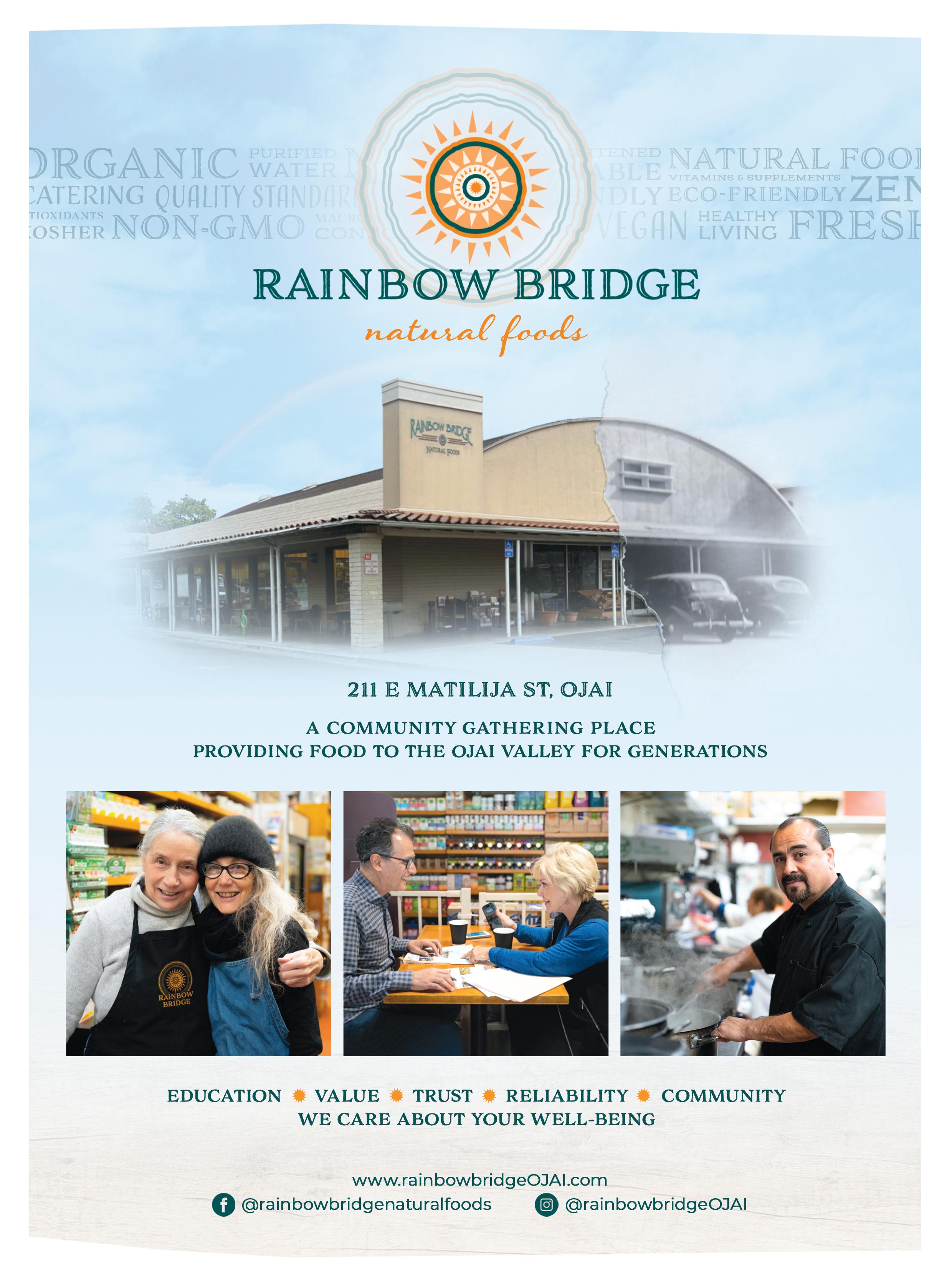Ojai & Ventura County
CELEBRATING LOCAL FOOD & DRINK, SEASON BY SEASON
























The World’s Fair of Pure Food










CELEBRATING LOCAL FOOD & DRINK, SEASON BY SEASON

































You may come for the ocean adventure, but you’ll stay for the culinary delights that ignite your senses. A vast kaleidoscope of flavors and meal options from your morning coffee to late-night libations. Here, suites meet the salty ocean, savor the moments at Zachari Dunes.



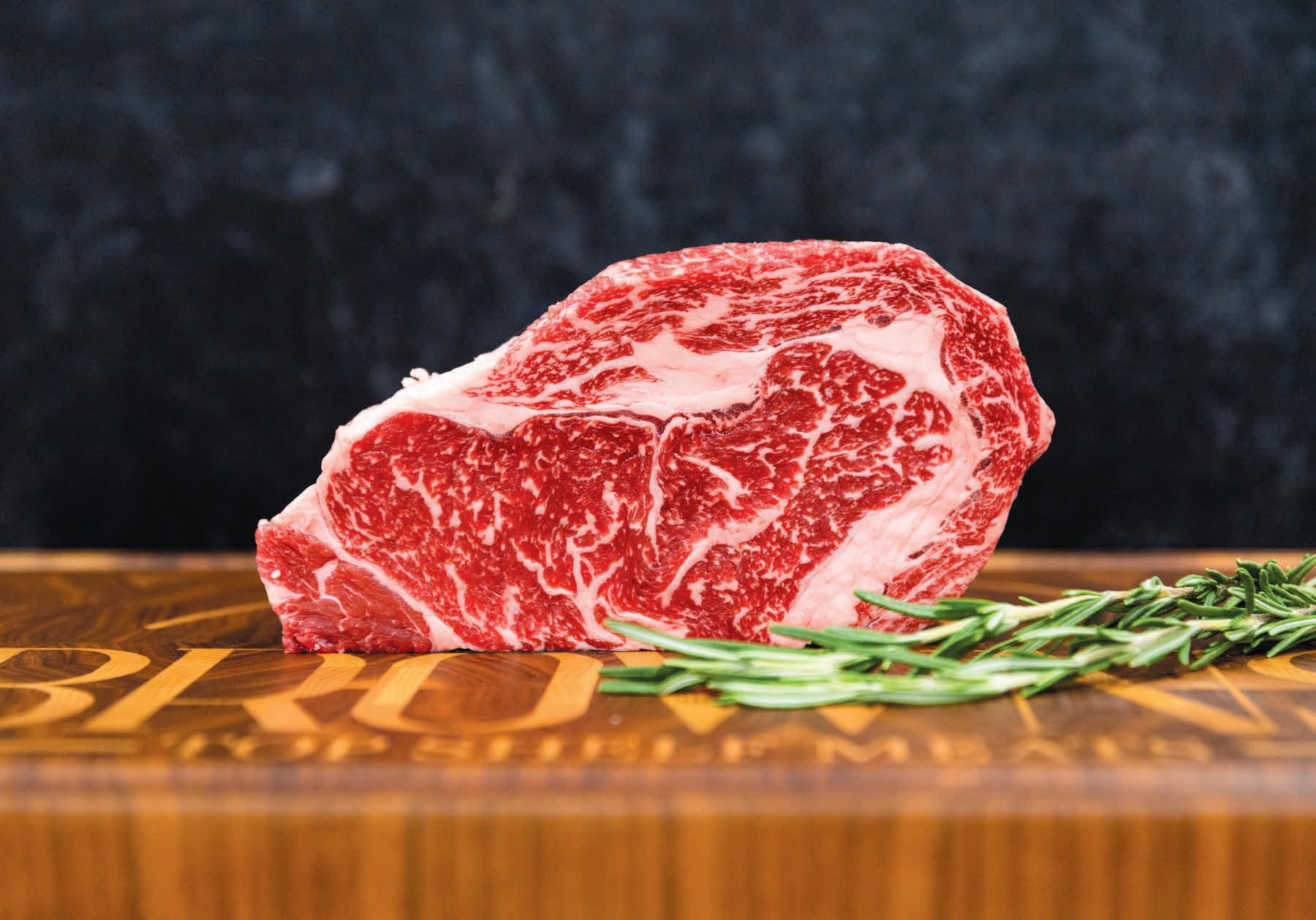



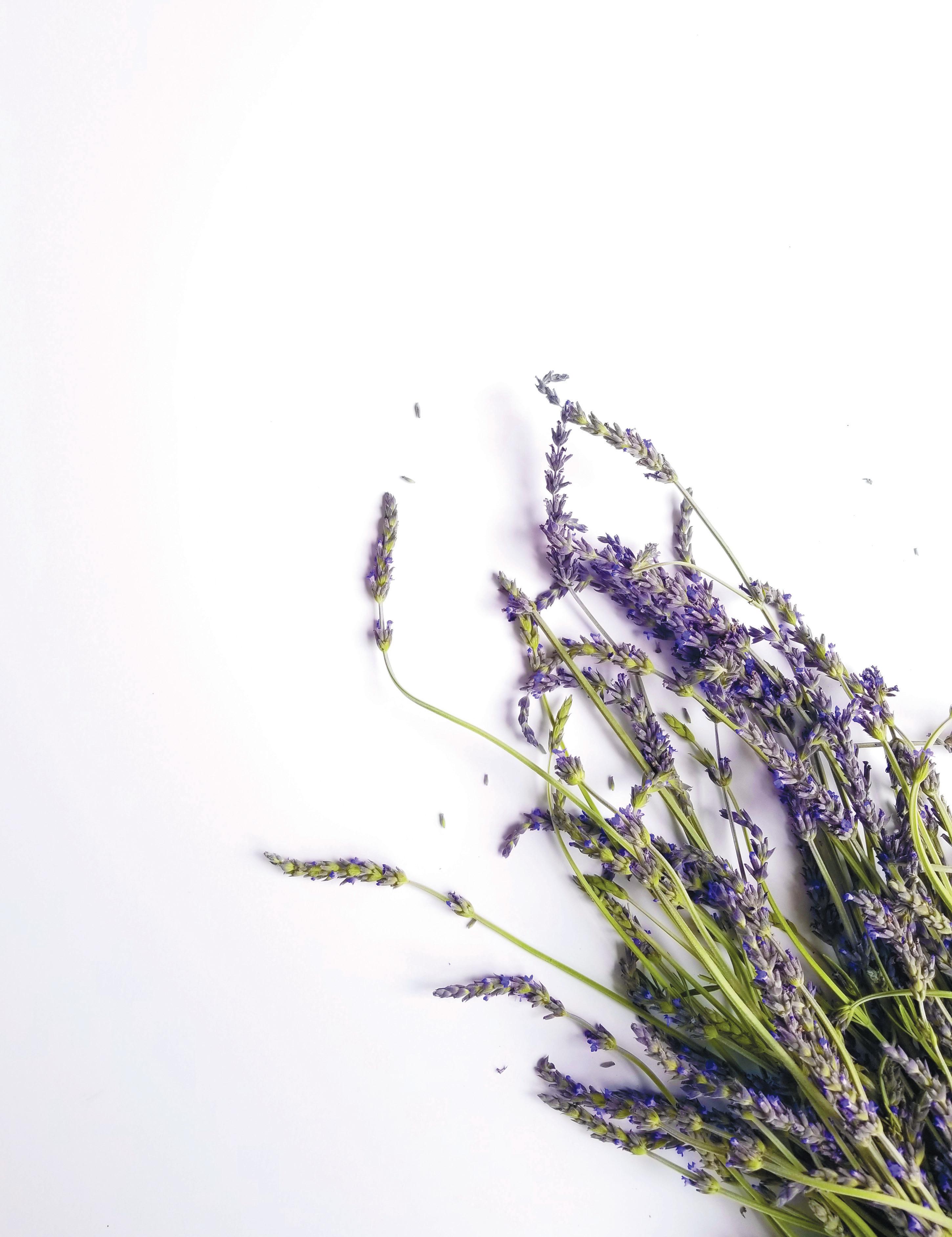
SPRINKEL
COVER: Quin Shakra, founder of Plant Good Seeds, captured this photo of his mentor, veteran organic farmer Steve Sprinkel, while the two were working in Sprinkel’s tomato field. Sprinkel shows up in multiple articles of this issue, (pages 8, 11, 12, and 42), just as he shows up in multiple stories in Ojai’s farming and food community.

Ididn’t intend to put long-time organic farmer Steve Sprinkel on the cover of this issue. In fact, I had two photos of the gorgeous lavender and honey recipe (page 18) all mocked up to decide between. But the photo of him, submitted by Quin Shakra of Plant Good Seeds (page 12), just felt so representative of not just this issue but of summer in general. The photo, like Steve, just kind of found its place at the center of things.
I personally don’t know him that well; I’ve spoken with him more via email and on the phone than in person. But you can’t tell the stories of food and farming in and around Ojai without seeing the inevitable connections to Steve Sprinkel.
Though I had been to his restaurant/market before, I first heard of him in 2018, from a young farmer just starting out, “If I ever get really stumped with a question, I’ll go to Steve Sprinkel and he’ll give me a poem or a little limerick and then tell me what I’m doing wrong,” he told me, laughing.
In 2019, Steve sent me a fantastic and encouraging email after filling out the MRI survey we sent out about readership of the magazine. He even included a sampling of his recent writing (which might still show up in a future issue). By then, I knew that he had also been a regular contributor to this magazine long before I came along.
I visited his farm on VC Farm Day that year, and a couple years later another farmer told me about how valuable regular gatherings around a table at The Farmer and the Cook (page 11) had been for his success in the field—and how Steve could be counted on for blunt truths.
I’ve seen this bluntness in practice. In a phone call about his article on garden mysteries (page 42), we chatted about ideas, upcoming seed expos (September 10–12!) and people. He told me that Heath Perry (Meals at the Market on page 10) might just be naive enough to make his great idea a success. (He went on to clarify that if he and his wife, Olivia Chase, hadn’t been naive at the opening of their restaurant/market, they never would have done it, so I think it was actually quite the compliment.) And you’ll see this same characteristic in quotes from Steve in at least three of the articles in these pages.
But here is the thing about Steve: Whether it is that he has had boots in the organic fields for more than 40 years, whether it is his partnership with Olivia (the eponymous Cook), whether it is his long-time advocacy for true organic farming, he gets that local food and community are vined together inextricably. Like lavender and honey, they are both symbiotic in their growth and delightful when served together. And he has certainly done his part to expand access to both.
To me this abundance and connection of food and community also epitomizes summer. So, how could I not put him on the cover?
Happy eating, friends,

®
Ojai & Ventura County
publisher & editor
Tami Chu
copy editor
Doug Adrianson
design
Cheryl Angelina Koehler
contributors
Erika Bolden • Tami Chu • Robin
Goldstein • Anne Kallas • Nicole
Leonetti • Larry & Christel Rogero
Steve Sprinkel • Joshua Weinerth
Sarene Wallace
photographers
Viktor Budnik • Tami Chu
Mariah Green • Stephanie Helguera
Quin Shakra
illustrator
Ramiah Chu sales
Mary DiCesare mary@edibleventuracounty.com
subscriptions
EdibleVenturaCounty.com
info@edibleventuracounty.com
contact us
Edible Ojai & Ventura County 2470 Stearns St. #142 Simi Valley, CA 93063
805-622-9355 info@edibleventuracounty.com

Subscribe at EdibleVenturaCounty.com to have copies delivered right to your door.
Check out our website, subscribe to our newsletter and follow us on social media @EdibleVenturaCounty for upto-date events, recipes and news from the food and drink community of Ventura County.

Founded 2002 by Tracey Ryder and Carole Topalian, Edible Ojai & Ventura County is published seasonally, four times a year. We are an advertising- and subscriber-supported publication, locally and independently owned and operated and a member of Edible Communities, Inc. Distribution is throughout Ventura County and by subscription for $28 per year. Every effort is made to avoid errors, misspellings and omissions. If, however, an error comes to your attention, please accept our sincere apologies and let us know. No part of this publication may be used without written permission of the publisher. © 2024. All rights reserved.







Sitting in the SunOven shop filled with the warmth and sweet smells of a bakery, it’s easy to see how Alexis Davis of Ojai has solved one of the more vexing problems in gluten-free baking: how to make good breads and treats without using wheat.
Bags of buckwheat, brown rice, sorghum, potato and tapioca flours bags are stacked throughout, all part of her carefully researched foray into the basic understanding of baked goods. And judging by the excited customers trickling through the door to pick up their treats, Davis’s breads and other baked goods are the successful results.
It’s a good thing Davis is determined and creative because after she and her son were diagnosed as gluten and dairy intolerant, she needed to change the diet of her family of five. All of them loved baked goods—like bread and doughnuts—that are made with traditional wheat flour.
While Davis and her son aren’t among those unfortunate souls who suffer with extreme reactions to gluten because of diseases like Celiac and Crohn’s, they do experience a physiological reaction after eating even small amounts of wheat gluten. Large amounts are seriously discomforting.
A stay-at-home mother of two sons and one daughter, and a licensed family and marriage therapist, Davis started exploring her options by researching various grains that could be used to create baked goods everyone in the family could enjoy. Her secret weapon has turned out to be buckwheat, which despite its name, doesn’t have any actual wheat in it.
“I wanted a healthy bread with lots of fiber that doesn’t need to be kept in the refrigerator,” she says. “After trial and error—we ate a lot of loaves of bread—I was successful. Eventually I
was able to work out the exact amounts [of ingredients] needed for excellent loaves to rise and bake.”
She started selling her products wholesale in 2014 and has garnered quite a following. The name reflects the bakery’s offerings: Simple Unique Nutritious and then “oven” because it informs customers.
Right now, SunOven is available all over Ventura County, including at JOI Café, Harvest Café and the Farmer and the Cook in Ojai, which was the first to carry the vegan, gluten-free baked goods. Olivia Chase—the “cook” in Farmer and the Cook—says she’s often the first to try new things. Especially if they’re local.
“I’m really grateful for what she does,” says Chase. “We use her pizza crusts and bread. But I didn’t know it was really important. We do tend to say yes to people. Sometimes it’s a fault that gets us in trouble.”
Just last November, Davis opened the first retail SunOven Gluten Free Bakery on North Ventura Avenue in Meiners Oaks to have one place to offer both direct to the public and increase the capacity of her wholesale production. In fact, the retail hours reflect when someone is already in working on wholesale, which makes the new space smart business. As a bonus, it is already popular. “People are driving from Los Angeles and Santa Barbara for doughnuts,” says Davis.
“I’m focused on growing the wholesale side of the business,” she says. “We would like to be tapping schools and hospitals. We eliminate 10 of 11 known food allergies. We are nut-free, which means that we don’t process nuts at this facility,” she says, adding that serving nonreactive food would solve a lot of issues for institutions that serve people with differing dietary needs.
But the main thing Davis wants is to be able for her family to live normally with their allergic restrictions. “I want it so my family can all sit down and have the same food or go to a birthday party with a cake everyone can eat,” says Davis. .
SunOven Gluten Free Bakery
11420 N. Ventura Ave., Suite 107, Ojai
Open to the public: 8am–4pm Monday–Saturday; closed Sunday SunOvenGF.com
Anne Kallas is a prolific freelance writer focusing on Ventura County. A fan of local, seasonal produce, she is the farmers’ market segment contributor for the LIVE 805 show on KVTA 1590AM. She lives in Ventura and is a former columnist, writer and copy editor for the Ventura County Star

The setting couldn’t be more bucolic. There is the lacy canopy of ancient oak trees overhead in the courtyard of the Ojai Unified School District building in downtown Ojai. Children are running and laughing and doing those magical things kids do, while they still can express joy and happiness with abandon. Farmers are selling seasonal produce. There is handcrafted sourdough bread from Ojai Rôtie and Stonybrook Kitchen and tamales from Me Gusta.
And there is the UpHut* booth, (formerly known as Market Meals).
According to Heath Perry, one of the founding members of the Ojai Community Farmers’ Market, the food booth (which he created and now runs with partners Ryan McAfee and Michelle Cassel) is an integral part of the overall mission of the market: to provide healthy, locally produced food for the community in a setting with music, playing, dancing and just catching up with friends.
But what makes this booth different than other prepared food booths? All the food is made onsite with the majority of ingredients (all when possible) purchased directly from the farmers and food makers AT the market.
“The goal is that when people come to the farmers’ market, we will always have organic, local food,” says Perry, who is a personal trainer by trade and was a registered dietician until he let his certification lapse.
Trying to find just the right balance and rhythm for the food booth has been much more of a challenge than his profession. He says the most difficult part of achieving that goal has been the sporadic nature of sourcing from small farms and food makers. “They won’t always have onions, for example.”
Tacos with meat from Casitas Valley Pastures are a big hit when they’re available, he says, although they are a bit pricey because the meat is local and raised organically. With prices ranging from $3 for the kid’s taco to $20 for a large taco bowl, it’s all part of the puzzle Perry is still trying to figure out.
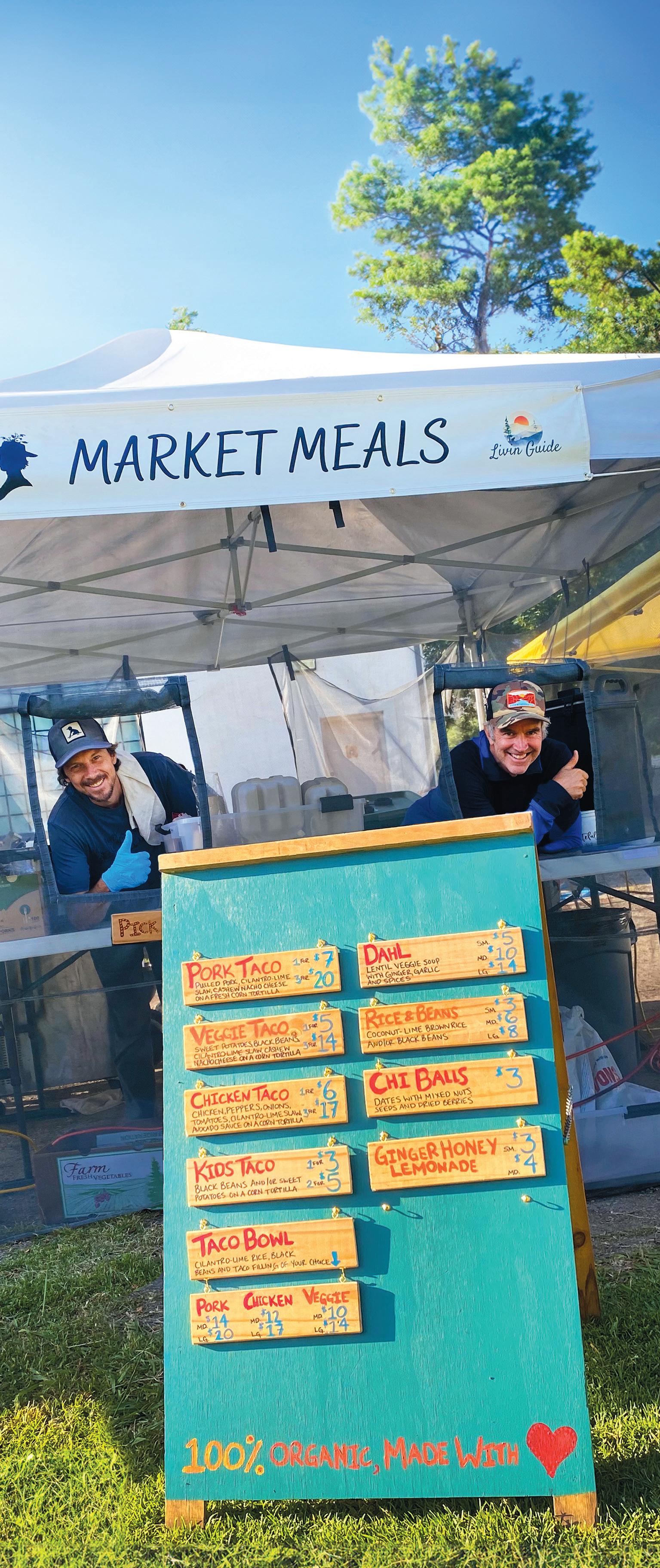
“People look at the price and just turn away. So, there’s something to consider. How can we make it [cost-effective] when compared with large fast-food operations, while keeping the better sourcing, taste and health we offer,” Perry says, adding, “We do everything we can to make our prices as reasonable as possible. It’s a slow growing process. We have the inexpensive option at the market too, tamales!”
Steve Sprinkel, one of the original board members of the farmers’ market, explains that it’s hard to get up to full efficiency at a new market. “It takes a while to develop,” he says. “[Heath] is designing his menu around a fresh, whole model. It’s about fresh products and cooking fresh. He’s walking his talk: buy local, fresh and all of those things.”
For now, Perry is making sure that there’s always something at his booth, whether it’s freshly made dahl using local ingredients or chi balls, with dates, nuts, seeds and other seasonal dried fruits, which he says provide energy. And the menu is expanding!
He wants to make the booth a reliable place for parents to send kids for a healthy tasty dinner they would actually eat. Perry says the rice and bean burritos for kids are a big favorite, even with some adults.
Perry has long-term goals for UpHut: “Our big-picture goal is to make the booth at Ojai Community Farmers’ Market sustainable and then eventually do some small events that have synergistic values,” he says. “Eventually we’d like to have a blueprint so that this model for farmers’ markets could be spread across the U.S. Every market should have a healthy food booth and make food sourced from their farmers and food makers. It just makes too much sense, and hopefully we can make it easier for people to replicate.”
For more information on the Ojai Community Farmers’ Market visit OjaiCommunityFarmersMarket.com.
*For more on how the UpHut got its name, see this story online.
If it sometimes seems as though The Farmer and the Cook is at the center of all that is good in the ever-growing healthy, sustainable, local, affordable food world in the Ojai area, that’s because it is.
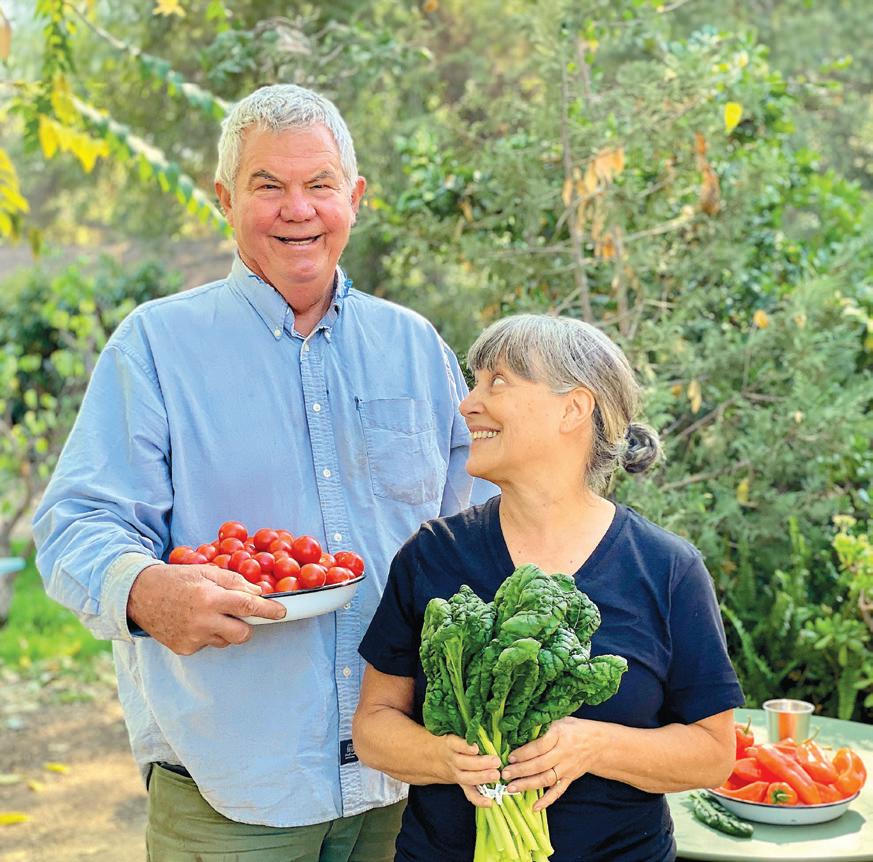
By chance, every “Notable” in this issue of Edible Ojai &Ventura County features either the restaurant/organic food shop or its owners Steve Sprinkel (the farmer) and Olivia Chase (the cook), the couple who have run the restaurant/shop for 22 years in Meiners Oaks.
“We really struggled for the first nine years,” says Chase. “In 2009, I think with the real estate crash, that’s when people started to notice us. I think the Internet has also started to help us a lot.”
And while the restaurant isn’t entirely vegetarian, it does lean in that direction. “Our mission was not necessarily to just be vegetarian, but also organic,” she says, adding that certified organic meat is fairly new to the area. “It’s all organic and healthy. Organic is our mission statement. That’s why Steve is so well-known.”
Sprinkel is on the board of directors for EcoFarm, which holds annual gatherings of thousands of organic farmers each year, as well as a member of other organic farm organizations.
He farms a 10-acre plot near the HELP of Ojai site on Baldwin Road for the community-supported agriculture (CSA) boxes sold through The Farmer and the Cook. He sees his mission as supplying fresh, organic, local food and showing others how to do so.
Sprinkel says getting the notoriously difficult organic certification is like doing taxes. “A lot of people think it’s too expensive, but the federal government underwrites 80 to 90% of those costs,” he says. “Besides, the certification is for the benefit of the consumers, not the farmers…. An independent third-party verification is good for the marketplace.”
Chase says The Farmer and the Cook has provided them with a long learning curve over the years. “It’s taken me 22 years to figure things out. I’m not a professional in the food business. We do say yes a lot. We haven’t always been tough,” she says. “But we’ve gotten more capable of being managers.”
They’ve also been able to improve the actual store with a remodel, new equipment and improved customer service.
“The only problem we have is parking. We don’t have enough parking,” Sprinkel says.
Chase and Sprinkel are sharing some of their knowledge with a wider audience in The Farmer and the Cook: Recipes and Farm Stories from Ojai, California, a new book featuring recipes from the restaurant plus some of Sprinkel’s writings. It’s available at their website, Farmer-and-the-Cook.com, and at their store, The Farmer and the Cook, 339 W. El Roblar Drive, Ojai; 805-640-9608.
by Viktor Budnik
Saving seeds from organic heirloom plants is becoming increasingly popular, says Quin Shakra, yet this business owner remains surprised that more local farmers aren’t participating in the practice, given an increasing interest in the healthfulness of “heritage” foods and emphasis on these plants’ origins.
But seeds are more, says Shakra, owner and manager of The Plant Good Seed Company, based in Ojai. His company not only offers a unique variety of seeds, it improves the farming conditions locally.
BY ANNE KALLAS PHOTOS BY VIKTOR BUDNIK

“In a lot of ways, people don’t really get seeds. They don’t know how to save seeds,” he says. “People—even good, ecologically based farmers—view seeds as input,” rather than as an integral part of the entire growing cycle.
According to Shakra, plants are bred much like livestock for desirable traits, either naturally or by humans. But hybrid plants—two plants bred together for two or more specific desirable traits— don’t reproduce as well. Their seeds will often produce unpredictable or even unproductive plants. “Hybrid plants will not save ‘true,’” Shakra says. “There are many people who intentionally save seeds from hybrid plants to ‘dehybridize’ and try to restore their traits via open-pollinated plant breeding,”
Plants that are bred “true” are those pollinated by wind, insect or animal. The seeds from these plants can be planted to grow with the same characteristics as the parent plant.
To create a variety of viable, true seeds, Shakra has needed to find a variety of farms and farmers. The first farmer to start helping collect seeds around eight years ago was Steve Sprinkel, the eponymous farmer co-owner of The Farmer and the Cook. According to Sprinkel, Shakra (a University of Oregon student at the time) started working at the restaurant almost 20 years ago. The farmer put the college student to work wherever he was needed, from the store to the fields.
“I’ve always grown seeds,” says Sprinkel. “It’s beneficial. It’s sort of a religion. They require a remarkable lack of participation.”
Shakra began his first plant-to-seed ventures on a spot formerly used by Sprinkel in Meiners Oaks. “Quin now has a cohort of producers and vendors,” says Sprinkel. “They will find some seeds going out of production and focus on cultivating that.”
Shakra says the importance of saving seeds can’t be overstated, especially on a regional level where conditions tend to be naturally similar for pollen and seed propagation. Each farm in the area has a vested interest in what is growing on surrounding farms.
For example, if one farm is growing striped zucchini, they might want to be aware of cross pollination with another nearby squash plant to figure out how to avoid it or plant in concert with that plant, if needed.
“It surprises me that even after a decade of doing this work, more local farms or farmers haven’t made the connection that locally sourced seed, or producing seed on farm, is a critical link of ecological regenerative agriculture,” says Shakra. “Local seed production

Quin Shakra sees a lot of his life in edges. He lives on the edge of an orange grove and farms his seeds on the edge of a creek and on the edges of another farmer’s field. Saving seeds is on the edge of mainstream and grassroots, so maybe it is right where he is supposed to be.
can increase a given crop’s bioregional suitability over time—think heat, drought tolerance, fertility / soil needs.”
While Shakra was initially involved in the production of every seed crop in the catalog, Plant Good Seed now gathers well-tested seeds from around 15 producers (of which he is one). Most come from Southern California, but others come from farther afield. Shakra says the biggest challenge is sorting and cleaning the seeds before packaging them.
Shakra grows his plants in the East End of Ojai, where he experiments with hardy native varieties. His field, on the edge of a creek there, is called Ivan’s Meadow after his cat.
All of the seed is organic and none is GMO, Shakra says, noting that GMO—or genetically modified organisms—isn’t a scientifically accurate term. The domination of patented seed varieties by a few large corporations makes wild or wind seed gathering and propagation a more important way to protect native plants so they remain accessible to everyone, he says.
Plant Good Seed offers its seeds in colorful packets, adorned with illustrations by Goda Trakumaite. Plants grown from those seeds will produce seeds that the home gardener can use after harvest. The best time to gather seeds tends to be late spring, early summer, or as the flowers develop seed pods, (though depending on the plant, seeds can be collected year-round).
Plant Good Seed packets are available at plant nurseries around Ventura County, at several small shops in Ojai or by ordering online at PlantGoodSeed.com. The seed catalog lists approximately 250 seed vegetable, flower, and herb seeds produced by 15 or so small seed growers. It also features a smattering of F1 vegetable hybrids for more serious growers.




In 2004, without a vision, we planted our first lavenders on our property in the Upper Ojai Valley, near the intersection of Highway 150 and Sulphur Mountain Road.
Prior to the planting, Jim Hall, a legacy Ojai farmer, nearby neighbor and superhuman being, helped us till in a couple of seasons of manure crop to nourish and prepare our soil. With his support we knew we had laid a solid foundation, and whatever we decided to plant would grow with gusto. We decided on lavender (Lavandula angustifolia) because of its perennial nature, drought tolerance and relatively low maintenance characteristics. It is also a plant with a unique, fragrant and beautiful bloom that paints a landscape with a variety of colors, shapes and sizes. And it attracts bees, butterflies and various other pollinators.
Our initial planting of approximately 600 plants consisted of three varieties that occupied 15 rows on about one acre of land. As we would later come to learn— time and laboring in the field have been our most influential instructors—we were a bit overzealous with our original undertaking.
Our lavender took to our healthy soil and matured beautifully. But now what?! We suddenly found ourselves a little too far out over our skis, so like all good would-be “farmers,” we improvised.
In what we now fondly refer to as our “Huck Finn Era,” we organized annual potluck harvest gatherings, charming our friends, neighbors and family to undertake the back-bending physical labor of harvesting lavender in the Ojai heat of June and July afternoons. In exchange, food, beverage and sometimes music were provided.
More often than not, our harvesting gatherings ended with dozens of people standing in our field of lavender basking in the glowing light of an Upper Valley sunset as the soothing cooler evening temperatures trickled towards us over Sulphur Mountain. As the music faded away, calm and quiet settled in, and tired young children were carried away in their parents’ arms. We knew we had created something special.
Next to the lavender field, a creek runs through the property where a cacophony of frogs and toads orchestrate each evening in late winter and early spring. Thus, Frog Creek Farm Ojai was born.
From these experiences, and at the suggestions of some of our friends (likely eager to retire as semi-pro lavender harvesters), we eventually decided to pivot to a U-pick farm. But before we could proceed, we had some work to do. Years of prolific growth had turned our clean, neat, multi-row field of lavender into a singular lavender blob. The number and density of plants in our original design had also inadvertently stunted growth and flower production. So began the arduous task of removing/transplanting every other row in our field to provide greater space for plant growth and visitor access.
We also decided to convert our lavender drying shed into a shady spot for visitors to escape the summer sun and double as an education center and tiny boutique to share the varieties of lavender we grow, and their various uses.
In 2014, with these major upgrade projects behind us, we needed a name. Next to the lavender field, a creek runs through the property where a cacophony of frogs and toads orchestrate each evening in late winter and early spring. Thus, Frog Creek Farm Ojai was born.
In the past 10 years, we have had the privilege of welcoming a diverse array of visitors from all over this planet. We have watched pregnant partners return with their babies and then year after year with their growing children. We have witnessed heartfelt matrimonial requests and joyful exchanges. We have openly shared our knowledge and understanding of these medicinal plants. Social media is littered with thousands of pictures of people enjoying the experience of our little farm.
Providing visitors with a sanctuary of peace and calm—a temporary escape from what is too often a stressful and tumultuous world—has been most important to us. We have seen and hope for a near-ethereal experience for our guests.
With dozens of people in the field the world is both great and small. The pace of life and breath slows. The mind quiets, stresses are momentarily forgotten. Visitors are together as a group, but alone in their private experiences. They are foraging, but not for food. Instead, it is for those unique moments in nature when something deep stirs within. A hush settles in, but observations are sharp. It is easy to become transfixed on a bee moving from corolla to corolla. If you close your eyes, you can better hear the hum of the pollinators, the call of a nearby warbler in the trees, the cry of the red-shouldered hawk high above or a gentle breeze moving the plants.
Because of Ojai’s long, hot summer days, our lavender bloom only lasts about six to eight weeks, which gives us natural boundary to our U-pick schedule. The sea of purple will begin in early June with the Hidcote and Royal Velvet; the field peaks during the early part of July and then fades as the July heat sets in. It’s during these days of high heat the lavender blooms become dense with their sweet oil.
The last major play of each season is the final harvest. In order to beat the heat, we arise before dawn to pick lavender stems and flowers remaining after the U-pick season is complete. We typically gather between 100 to 150 pounds of flowers (weighed without the stems) during that last push, which we then distill into our annual vintage of lavender oil—our most beloved product. Depending upon seasonal conditions, we generally make 35 to 45 ounces of pure lavender oil, most of which is available for purchase in our boutique.
Our 2024 season opening date is June 22. U-pick days are Saturdays and Sundays from 9am–1pm, with a special golden hour picking on Saturdays ONLY, 6–8pm.
For more information visit FrogCreekFarmOjai.com or on Instagram @frogcreekfarmojai.

In the spring of 2023 we cultivated an additional 250 plants on land adjacent to our legacy field. These “babes” produced a minimal crop last summer but will contribute in small part to our 2024 harvest. Between the two fields we have now have five varieties of lavender.
Lavandula x intermedia Grosso: This is our most prevalent plant, and is the primary contributor to the production of our distilled lavender oil. It has a deep, dark purple flower that is also great for dry cut bunches.
Lavandula x intermedia Provence: A paler, greyish flower, but its fragrance is highly sought after. It takes a handful of years to mature. Our 15-year-old overgrown plants were removed in 2021 and individual starts replanted that same year, so these should be hitting their fragrance stride this summer.
Lavandula angustifolia Hidcote: We grow a unique dwarf variety that creates small dry cut bundles. It’s a visual fan favorite with its compact, vibrant purple, velvety flower spikes.
Lavandula angustifolia Royal Velvet: Very similar in color and texture to the Hidcote but with a more spacious flower spike, longer stem and a sweet, pleasing fragrance.
Lavandula angustifolia Miss Katherine: The distinct characteristic of this lavender is the pinkish, white flower spike it produces, which adds a unique accent to lavender wreathes.



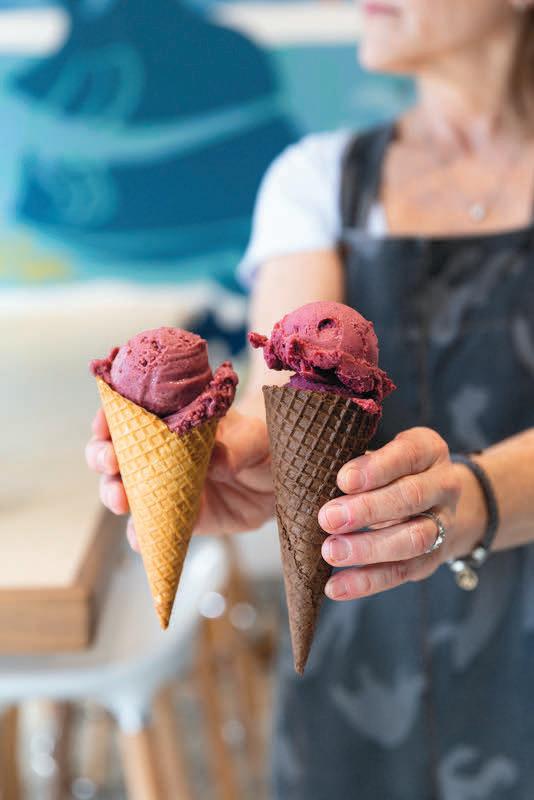




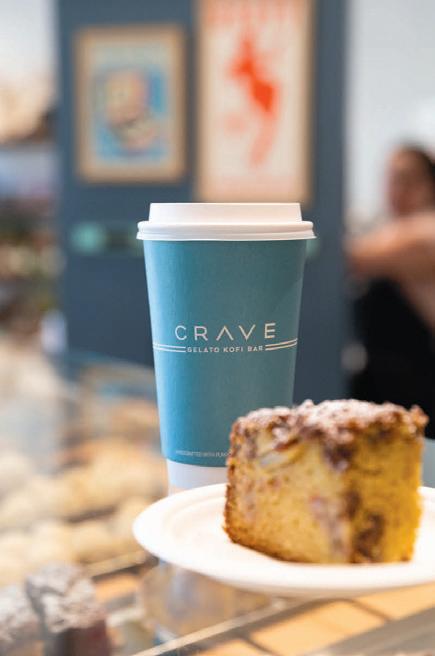

This warm dip is a taste of summer in a dish. Even if you aren’t a fan of goat cheese, the combination of fresh fruit and honey gives this dish an addictive quality that will have you coming back for more. It is perfect as an afternoon snack or a party dip, just don’t expect leftovers!
Serves 4
½ teaspoon sea salt
Pinch of ground black pepper
2 teaspoons ground culinary lavender
½ cup olive oil
1 baguette, sliced
8 ounces soft goat cheese log, room temp
1 cup sliced fresh seasonal fruit—plums, peaches, figs, berries
Local honey
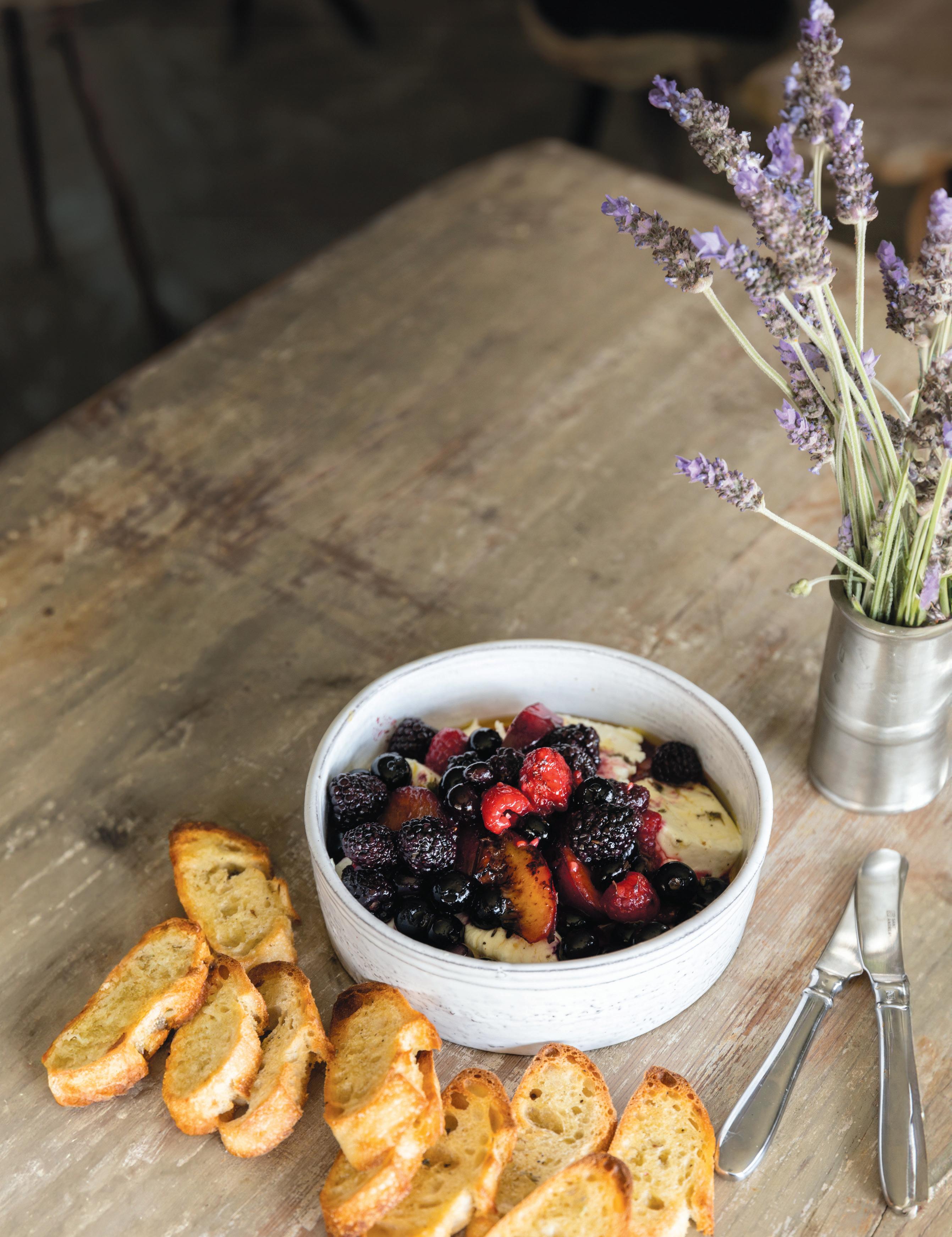
Preheat oven to 375°F.
Mix salt, pepper and lavender with the olive oil; brush lightly over bread slices. Reserve any leftover oil.
Place bread slices on a baking pan and slip into the oven for about 10 minutes, until toasted. Remove from oven.
Slice goat cheese into 1-inch medallions and place in a shallow ovenproof serving dish. Top with sliced fruit or berries and drizzle with any remaining seasoned olive oil. Bake uncovered on the top rack for about 15 minutes. When cheese and fruit is bubbly, the queso is ready. Remove hot dish from oven, place on a serving plate, and drizzle with honey. Serve warm with toasted baguette slices.
Garnish with fresh lavender sprigs.
Honey is like a sponge with flavor. It will take the flavor of anything that you put in it. Aromatic dried herbs such as rosemary, thyme and mint add deep flavorful tones.
Fragrant spices like cinnamon, cloves and star anise pair so beautifully with the floral sweetness of local honey and can liven up and enhance many of your recipes. Explore and discover with different honey, whole spices and herbs to create unique infusions.
Important note: Since moisture can cause honey to go bad, any chili, pepper or herb must be completely dried before you place them in the honey jar to infuse. As long as no water is introduced into the honey, it will never expire.
Here are some of my favorite ingredients to infuse:
Cinnamon
Ginger
Jalapeño or other hot peppers
Lemon
Rosemary
Lavender
Thyme
Vanilla
Cardamom

To infuse honey: Fill a clean glass jar or other container about one-third to onehalf full of your choice of whole dried herbs or spices. Add raw local honey to fill the jar.
Let sit at room temperature until your desired flavor has been achieved, at least 1 week. The flavor will grow stronger the longer you leave it.
Drain honey and store in a cool dark place.
Infused honey can be drizzled on foods, used in baked goods or even as a sweetener for cocktails.
You can never have enough dessert recipes, especially during the mid-summer, when peaches are at their peak. I have taken one of my favorite methods of cooking— stove top pan-roasting—and used this technique to create this heavenly dessert, revealing gorgeous roasted peaches, shimmering with caramelized fruit juices. Other seasonal summer fruits, like nectarines, plums or apricots, also work very well. Make a good thing even better and accent the caramel notes of the peaches by finishing off with this homemade salted caramel sauce dripped over vanilla ice cream, or a spoonful of creamy mascarpone cheese.
Serves 6
3 firm peaches, cut in half and pitted
3 tablespoons unsalted butter
½–¾ cup infused honey (recipe below)
Pinch of sea salt
Vanilla ice cream or mascarpone cheese, optional
To pan-roast the peaches, heat a cast-iron skillet over mediumhigh heat and warm the butter with about ½–¾ cup of infused honey in the hot pan with a generous pinch of sea salt. Once the butter has melted, arrange the fruit in the skillet, cut side down. Cook for 3 to 5 minutes without disturbing the fruit, until the cut sides begin to brown and caramelize. Reduce the heat to low and continue to pan-roast for another 5 minutes* or so, until fork tender. Flip the peaches over and baste with the honey butter and caramelized juices, then remove from heat.
*The total cooking time will depend on the ripeness of your peaches or stone fruit; firm fruit is better than super soft for this recipe.
Transfer pan-roasted fruit to serving dishes. Drizzle the honey butter sauce from the pan over the roasted peaches. Dollop some ice cream or mascarpone cheese on top and serve immediately, with some extra sauce on the side.
For the infused honey (make ahead)
1 cup honey
2 tablespoons dried lavender
1 tablespoon fresh rosemary
Infuse the honey with lavender and rosemary according to the directions on page 19 and let sit for about a week.
Store any remaining infused honey in a covered jar for other uses; it’s wonderful drizzled over fresh summer fruit or as a sweetener for hot or iced teas.

by Robin Goldstein

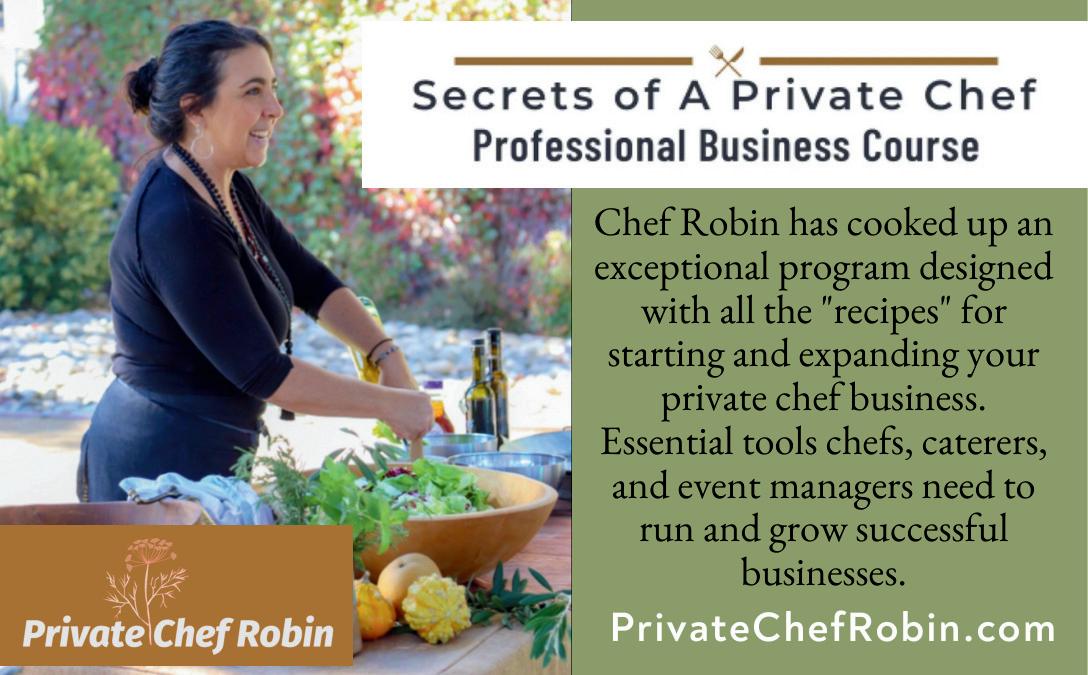
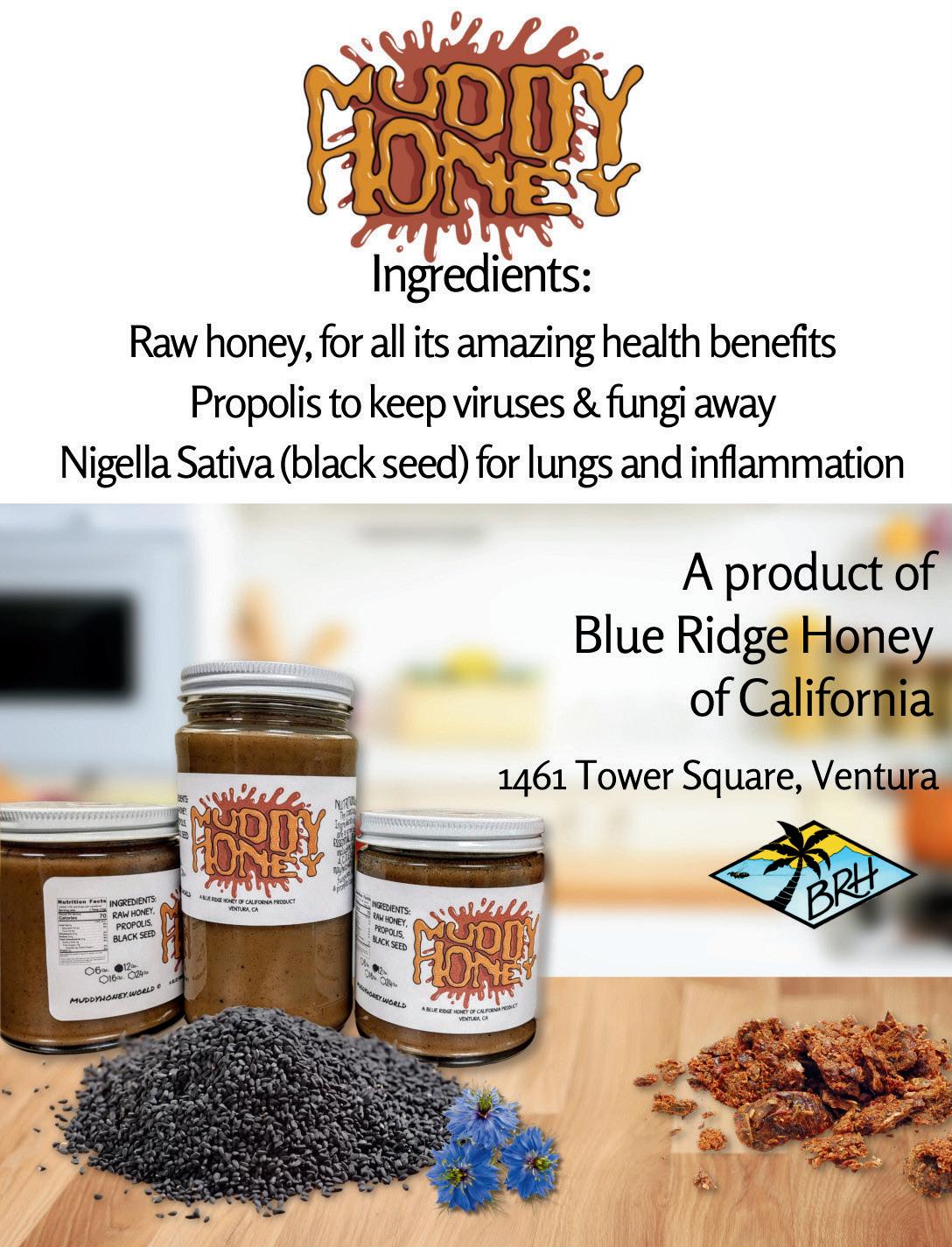





Are you craving the rich flavor of a cheesecake but don’t want to heat up the kitchen? Try this raw version with plenty of healthy proteins and nutrients to keep you energized this summer.
Serves 12
For crust
7 ounces raw almonds
3 ounces raw cashews
4 large pitted dates
1 teaspoon ground culinary lavender
3 tablespoons honey
1 tablespoon organic coconut oil
Pinch of salt
Process almonds, cashews and dates in a food processor until crushed. Add lavender, honey, coconut oil and salt; process until combined. Transfer and flatten the “dough” onto the bottom of a 10-inch springform pan (or, if making individual servings, into mini-muffin cups).
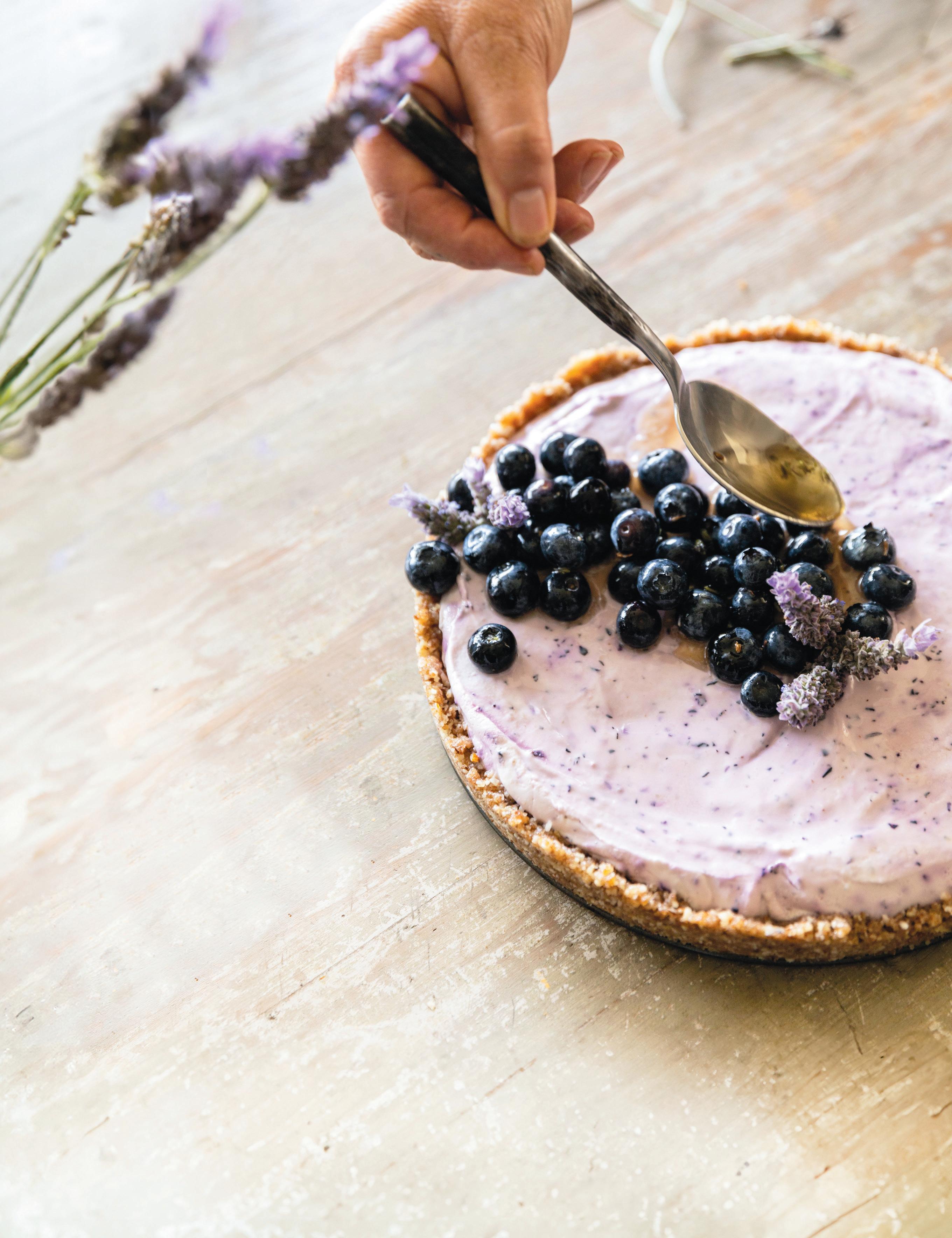
For filling
28 ounces cream cheese, room temperature
1 pint fresh blueberries, washed (reserve about 12 berries for garnish)
3 tablespoons honey
2 teaspoons ground culinary lavender
2 teaspoons sugar, plus a pinch for the top
Combine cream cheese and fresh blueberries in a food processor. Pulse until all is blended with a smooth buttery texture. Add honey, lavender and sugar and pulse just until incorporated.
To assemble: Spoon the filling onto the crust, sprinkle with a little granulated sugar and refrigerate for at least 2 hours. Top the cheesecake with the reserved blueberries to garnish.
Robin Goldstein’s cooking career has been centered in California, where she has been preparing foods for 30+ years. She brings to the table a deep-felt art of balancing flavors while interacting with her private clients in their homes. She shares her delicious recipes through her popular cookbooks, perfectly paired for those who seek savory Mediterranean-inspired flavors. PrivateChefRobin.com

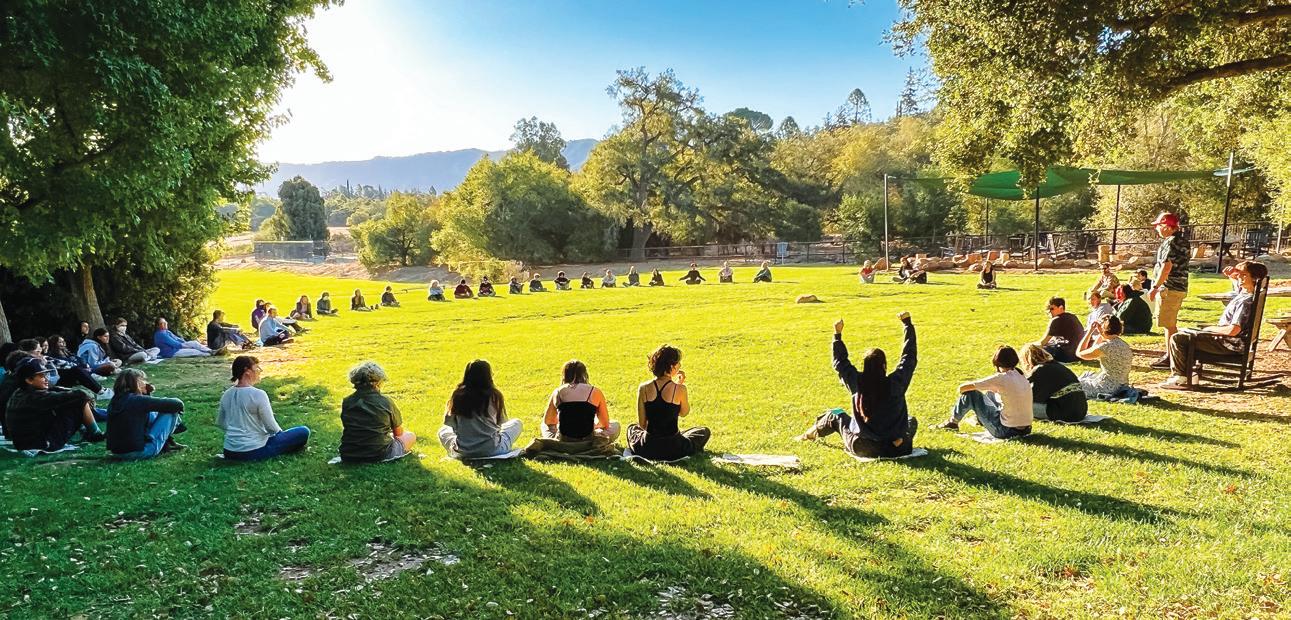

At Oak Grove we approach teaching, learning, and living as an art form – The Art of Living and Learning. Our students are given tools to build life-long practices of intellectual discipline, strong communication skills, self-reflection, empathy, and clear thinking. Our high school’s challenging college-preparatory curriculum is designed to exceed admissions requirements for the most selective universities across the country. The Outdoor Education and Travel Program is an essential component of Oak Grove’s approach to education. Whether walking through our 150-acre oak-studded campus in Ojai or traveling to India as a senior, students are provided with many opportunities to learn from nature, build lasting friendships, develop cross-cultural understanding, and become active stewards of the environment.








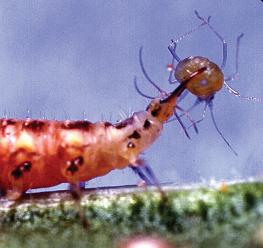





We are in a golden age of beekeeping, with access to modern tools and information making the practice accessible to anyone regardless of background.
Your best bet for getting started is to join a beekeeping group in your area. Blue Ridge Honey has monthly beekeeping group meetings at their facility on Tower Square in Ventura. Call for information: 805-941-3777.
Before beginning any backyard beekeeping, check the county and your city manager to see if it’s legal to have a bee colony on your property. Do plenty of research to fully understand all the regulations and legal issues surrounding owning and managing a beehive. According to Ventura County Code Section 8107-2.6.2 it is legal to have up to four colonies on a lot of 10,000 square feet or more. There are a host of other requirements so I recommend calling the county (the Apiary Inspector is at 805-388-4222) to avoid issues in the future.
To get started, you’ll need just two things: some bees and some basic equipment.
There are many subspecies of the Western honey bee (Apis mellifera), each with benefits and drawbacks. Picking the right bee for you is a huge part of getting started on the right foot.
My personal recommendation would be the New World Carniolan, an incredibly hardy bee that is also very gentle. Some of their greatest traits include their pronounced ability to survive difficult winters and the ability for a rapid spring buildup.

If you’re going to start beekeeping, I suggest buying your bees from a reputable source, either a local beekeeper you know or a commercial company like Dadant or Mann Lake. Bees are capable of hybridizing with other subspecies and in Ventura County we have a healthy population of the African subspecies. As a result, wild colonies can become quite aggressive once established.
Beekeeping is an entire world in and of itself, with so many unique and interesting tools that vary among climates, cultures and personal preferences. The bare minimum a new beekeeper might need would be a smoker, a protective suit, a hive tool and some bee boxes with frames to house your bees.
The hive tool is a multi-functional tool used to open the hive, lift frames, scrape wax and more. You’ll need it to get started, but likely find it to be invaluable long term. There are several styles, sizes and uses to choose from, so spend a little time looking into them before deciding which one to buy.
Equipment can be very expensive but there are plenty of workarounds and practices to make sure you get the most bang for your buck. For example, you could share some of the equipment with another amateur beekeeper, or rent a smoker or suit when it is needed.

Not all honeys are created equal. To make sure you’re purchasing 100% real honey, follow these tips:
Buy Local: Purchase honey from a local beekeeper or farmers’ market vendor. Talk to them and you’ll learn a lot about the honey and where the bees foraged. (This honey likely will be more flavorful, too.)
Just One: Honey should be the only ingredient. Stay away from any honey that contains high-fructose corn syrup, maltose syrup, glucose or fructose.
Good Words: “Raw” and “unfiltered.” This honey will have more health benefits than processed honey.
Organic Truth: If honey is labeled “certified organic,” it was imported and certified by the country of origin. (The USDA cannot certify honey as organic.)
Not Ultra: Stay away from honey that’s “ultra-filtrated.” In this process, honey is heated and forced through tiny filters to catch the pollen.
Certified: True Source Honey is a nonprofit organization that grants honey the “True Source Certified” label. This means the honey can be traced from hive to home and has been tested for authenticity and third-party audited.
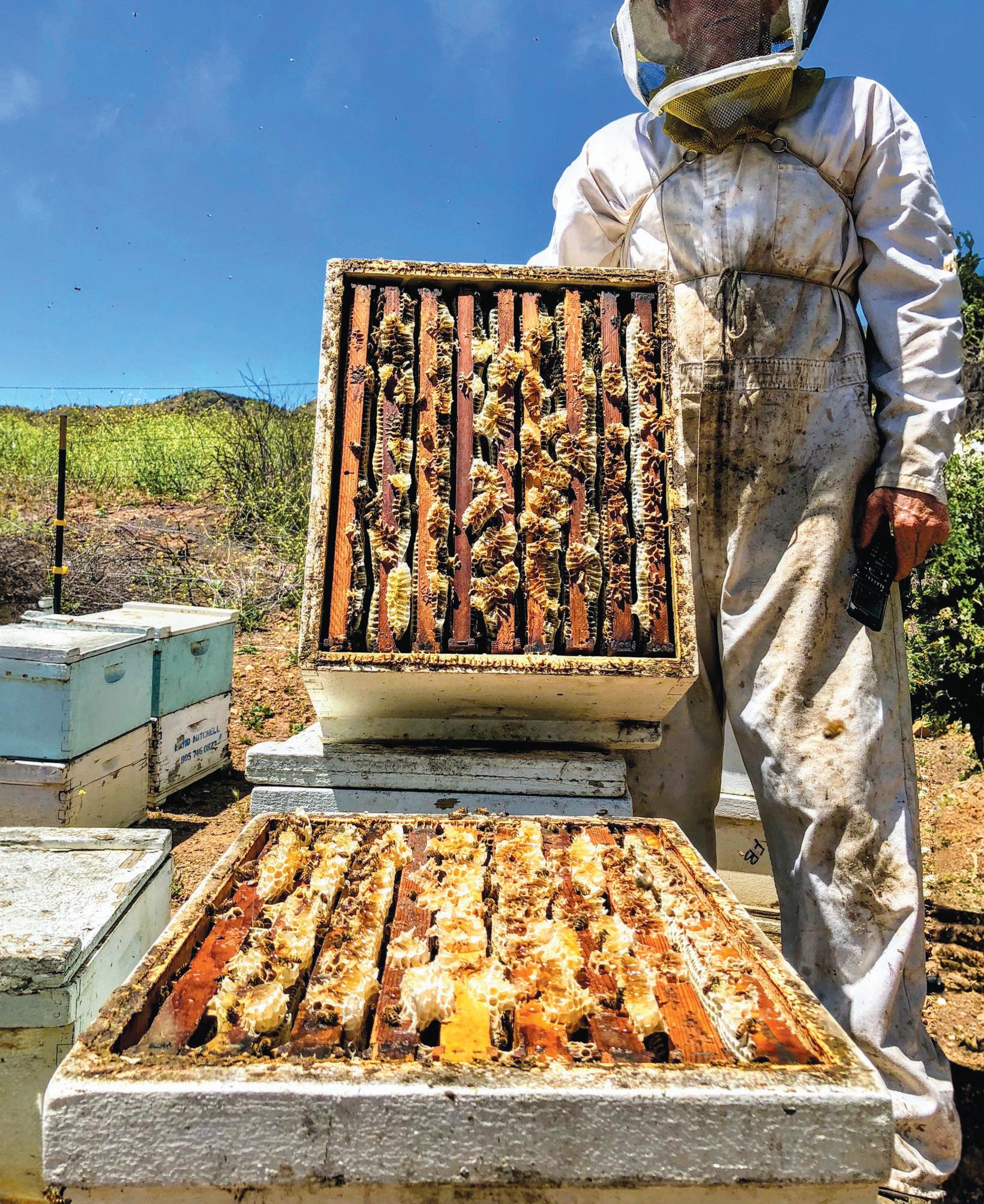
The bees are impartial as to the cost of your equipment, so long as your hive boxes keeps water out and heat in. New or used equipment (boxes, smokers, suits, hive tools) works equally well, however I would recommend using new frames as bees often prefer to build their own combs.
The best time to order bees is in the fall, so they arrive in the spring. Spring is the best time to begin, when there are plenty of nectar and pollen resources available for the bees and when colonies grow the fastest. Make sure to have a spot picked out for your new bees, preferably an area with lots of direct sun, a nearby water source and space in front of the hive entrance to allow for a clear flight path.
Once your bees are established in their new home be sure to assess them about every two weeks. When the colony is getting close to filling their current box, add another on top to give them room to grow and prevent the hive from splitting or “swarming”—a natural process that occurs most often when a colony runs out of space. Bees will naturally store honey in the upper boxes, which allows heat from the lower brood chamber—where the eggs, larvae and pupae develop—to rise and keep it liquid (and also conveniently makes it very easy to harvest honey)! Once the box is full and capped, meaning the honey is covered in wax, it is ready to harvest and you are on your way to liquid gold!
Joshua Weinerth is the founder and owner of Berell Bees Co., currently manages 120 colonies and is attending Ventura College. He is a third-generation beekeeper; his grandfather started beekeeping 1951 in Burbank. He has been exposed to bees all his life, and has been a professional beekeeper since 2020.
Where to find equipment and bees in Ventura County and nearby: Bryan’s Bees: BryansBeesVentura.com
Mission Beekeeping: MissionBeekeeping.com
The Valley Hive (Chatsworth): TheValleyHive.com
Santa Barbara Beekeepers Association: sbba.org
Where to buy honey in Ventura County:
Blue Ridge Honey, Ventura
Bennett’s Honey, Fillmore
Heavenly Honey, Ojai
Heritage Honey, Ventura
Ojai Community Farmers’ Market
Ventura County Certified Farmers’ Markets, Ventura, Thousand Oaks
Camarillo Farmers’ Market
Simi Valley Farmers’ Markets
Underwood Family Farms
You don’t have to be a beekeeper to support bees. Los Angeles beekeeper David Bock put together this list of ways you can be a honey and help bees thrive.
See a Bee, Save a Bee: If you discover a swarm of bees on your property, call a live bee remover instead of an exterminator. In Ventura County some options are Ventura Bee Rescue, 805-620-7290; Sunshine Honey and Bee Removal, 805-765-1450; or Bryan’s Bees, 805-557-8091.
Put the Spray Away: When bees encounter pesticides while foraging, they bring the poison back to the hive. Too often, the result is the death of most or all of the bees in the colony.
Bloom Where You’re Planted: Provide pollen and nectar for bees and other pollinators by planting California Buckwheat (Eriogonum fasciculatum) and Black Sage (Salvia mellifera) or the perpetually blooming Tuscan Blue Rosemary (Rosmarinus officinalis “Tuscan Blue”).
Also consider non-native trees like eucalyptus and Sydney golden wattle (Acacia longifolia). These Southern-hemisphere species bloom in the winter months, providing bee forage when it’s needed most.
Hire a beekeeper: In the East County, Phoebe Piper runs The Hive Tribe, a local business that will set up and maintain the hives for you in your backyard. TheHiveTribe.com
Call a Sideliner: If the prospect of hosting thousands of bees in your yard is daunting, consider sponsoring someone else’s hives. Small-scale professional beekeepers, known as “sideliners,” will gladly exchange honey and guided apiary tours in exchange for a monthly donation. Contact David Bock at david@buzzedhoneys.com for details.


“Just give me the regular honey,” says a customer at the farmers’ market to one of the local honey vendors.
Since this is a fairly frequent request, the response is always something like, “Can you tell me what flavor you think of when you think of ‘regular’ honey?”
“You know,” says the frustrated shopper, “the one that tastes like honey!”
Did you know that there are as many variations of honey flavor as there are flowering plants that honeybees visit? In fact, honey can have variations as distinctive as wine, with factors like weather, climate, soil, season and type of flower affecting the flavor and color. Even honey from the same hive can have drastic differences in flavor from season to season.
The U.S. Department of Agriculture recognizes seven distinct colors of honey and measures it by using the Pfund color grading system. To understand this scale and how it works seems to require several advanced degrees, and really, as a consumer it just helps to know that honey can range in color from colorless or “white” to “dark amber,” and often the strength of flavor corresponds to the strength of color.
In Southern California, we have several fairly common honey flavors, and while they vary by season, there are enough consistencies to have confidence in what you might expect when you purchase.
To taste these unique flavors yourself, visit honey vendor booths at many of the local farmers’ markets and ask lots of questions. Or, host a honey tasting party and ask guests to bring specific honeys to share.


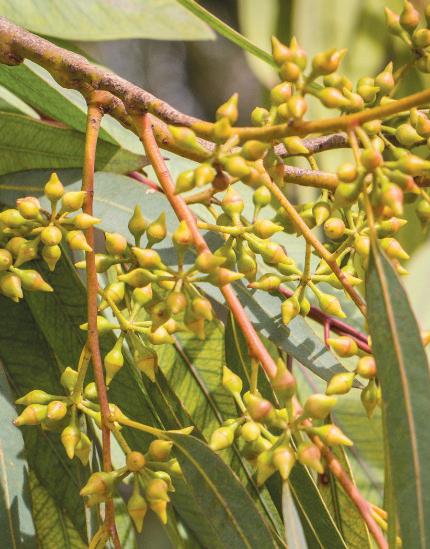



1 2 3 4 5 6 8 7 9
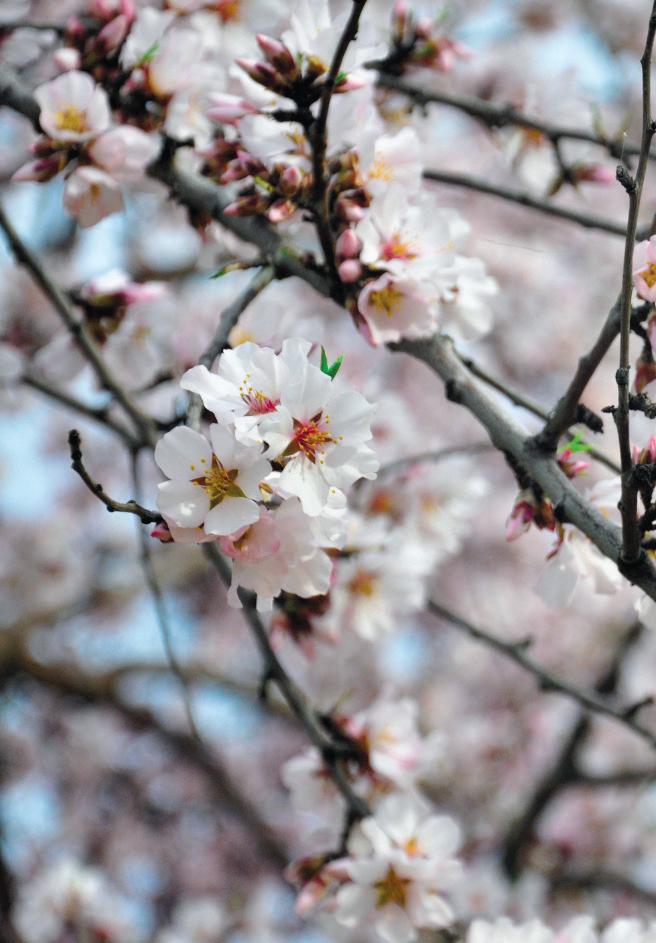
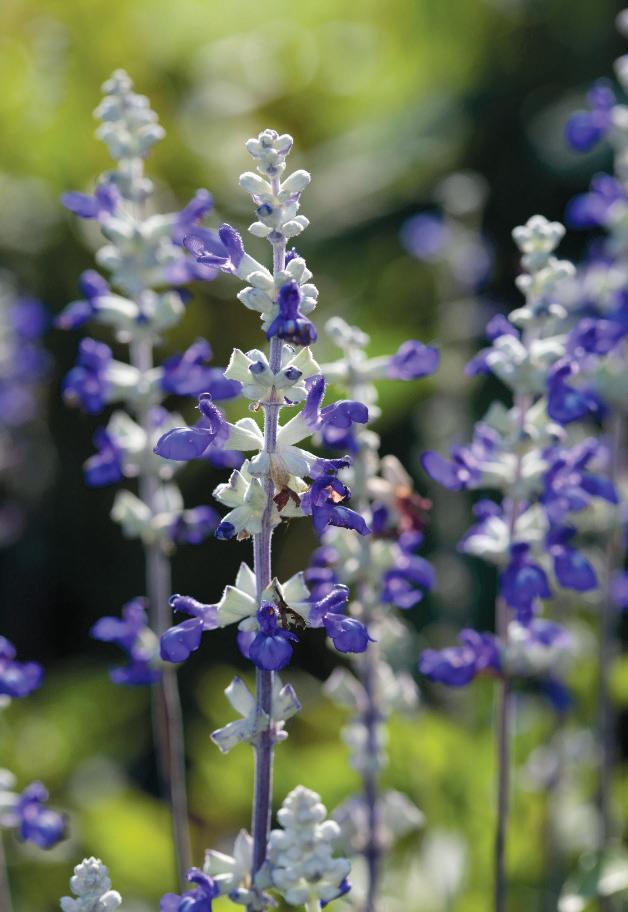






Generally produced in late fall in the heady flowering orange groves, this honey is very regional.
Color: Light to medium amber
Flavor: Aroma is distinctively citrus, sweet honey with orange blossom flavor and hints of rose
Best for: Sweetening teas, baking, dressings and daily use
Though eucalyptus is not native to California, this honey has become as common as the trees in our region. But be sure to find it from backyard or small producing beekeepers, or it will likely be imported from Australia.
Color: Light to medium amber
Flavor: A cool menthol flavor with an herbal malty aftertaste
Best for: Sweetening teas
Specific health benefits: Said to helpful in reducing cold symptoms and headache pain
The bees that produce this honey are often housed in hives within avocado orchards and collect pollen from the avocado blossoms.
Color: Dark amber
Flavor: Rich and buttery, strong.
Best for: Salad dressings, cocktails, and sauces
Only available from specific local beekeepers with fields of buckwheat nearby, this honey is said to have extremely high levels of antioxidants present.
Color: Dark amber
Flavor: Strong, malty with molasses overtones and a lingering aftertaste
Specific health benefits: Said to be good for wound recovery, helpful in reducing cold and flu symptoms, especially coughs
Found locally from beekeepers who keep hives in lavender fields, this honey is surprisingly flavorful, even if one doesn’t like lavender.
Color: Light to medium amber
Flavor: Medium sweetness, hints of camphor and sweet tobacco
Best for: Served with baked brie and sweetening lemonade
Like avocado honey, this comes from hives set in almond orchards during the blooming season season, but is not as common due to its bitter flavor.
Color: Dark amber
Flavor: Strong, nutty with a slight bitterness
Best for: Savory dishes, ravioli fillings, meat sauces
This honey comes from the nectar of white blossoms on the clover plant. It is what people often consider “regular honey” because it is the most common honey in the world. According to local beekeeper Wendi Mitchell, most commercial clover honey will be imported from the Dakotas or Northern California.
Color: White to light amber
Flavor: Mild with slightly tangy aftertaste
Best for: Baking and everyday use.
One of the most common flavors for bees set in the L.A. and Ventura County hills, this honey is distinct and strong.
Color: White or water white
Flavor: Pungent, herbal with a floral aftertaste
Best for: Charcuterie boards, or served with cheese.
Most common after a wet spring, wildflower honey could be made from any flowers, so the flavor will vary widely depending on region.
Color: Light to medium amber
Flavor: Tends to have floral notes, a lighter flavor
Best for: Everyday use, cocktails, making jun or kombucha
Camarillo Barrel Works is the home of Cantara Cellars and Flat Fish Brewing Co. In January 2024, after almost five years rallying support at the California state capital, the company added Cantara Distillery to their marquee.
Mike Brown grew up in Lodi, where winemaking was a dominant industry. After attending Cal Poly for mechanical engineering, he left the tule fog of the Central Valley behind for Southern California’s more temperate climate.
Brown’s 11,000-square-foot production facility and tasting room, which he operates with his wife, Chris, comprises four suites that the business has expanded into over the course of six years and four phases. Where the original winery tasting room served flights and glass pours, they now have a dedicated kitchen. “We built the kitchen in our first phase,” he says, “then reset equipment for a full kitchen in our fourth phase.”
The current tasting room opens to a large warehouse lined with oak barrels. To visitors enjoying the space for live music, games or events it simply looks like a barrel room. What they may not know is

that within that cooperage, wine barrels rest alongside spirit barrels, a powerful symbol of the effort it took Brown and others to change California law in favor of craft beverage manufacturers.
Brown makes the connection between winemaking, distilling and brewing sound seamless. “It’s an Old World concept,” says Brown. “In the fall you make wine; in the winter you distill it and make brandy; the rest of the year you brew beer.”
Using wine to make brandy-based spirits isn’t just a compelling trade with a tasty result. Utilizing runoff for distilling ensures that grapes which have taken valuable agricultural resources aren’t wasted, and that small businesses are employing all avenues to maintain their financial stability.
Years of experience in the wine and beer industries have provided Brown with ancillary skills that he applies to making brandy. Brown surprised another craft distiller by taking samples of his brandy as it moved through distillation, a product-control process he attributes to brewing. He refines the influence of oak on the brandy during aging by utilizing toasted oak staves, a common practice in winemaking.
Makes 1 drink
½ teaspoon absinthe
1½ ounces Cantara Cellars brandy
1½ ounces rye whiskey
½ ounce simple syrup
4 dashes Peychaud’s Bitters
Rinse a 10-ounce rocks glass with ½ teaspoon of absinthe. Discard excess absinthe. Add a large chunk of ice into the prepared glass. Combine other ingredients in a mixing glass or cocktail shaker; add ice then stir for 30 seconds.
Strain into prepared glass. Express a large lemon peel over the glass and drop it into the drink. Serve!
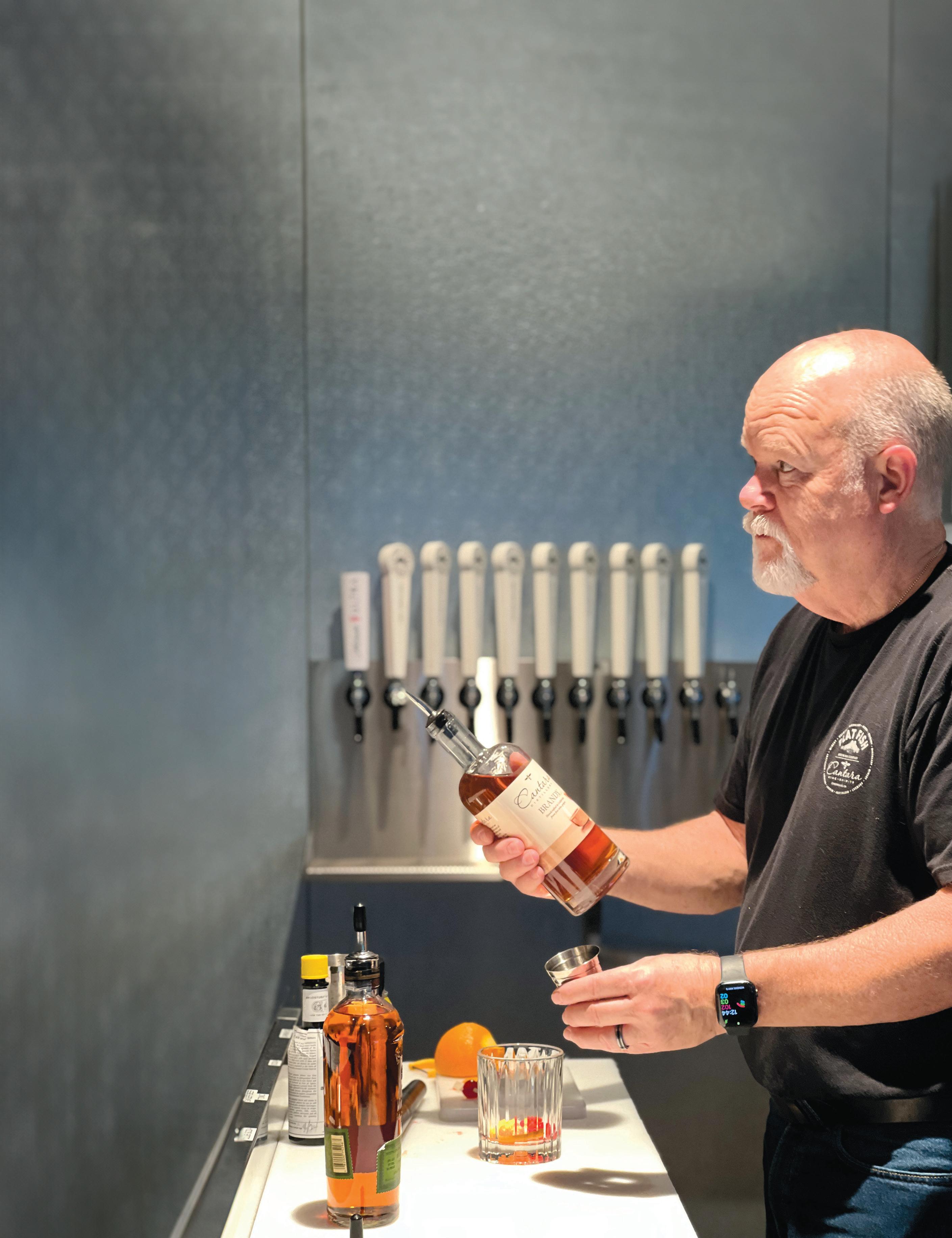
Mike Brown might be found mixing cocktails at the new bar or working in the barrel room at Camarillo Barrel Works which he co-owns with wife Chris.
Opposite: “Winery Dog” Sandy Sue (15, or 105 in dog years) loves every day she gets to spend at the tasting room.
“It’s an Old World concept: In the fall you make wine; in the winter you distill it and make brandy; the rest of the year you brew beer.”
—Mike Brown
Brown saw the increasing interest in cocktails years ago when he began making moves to add a spirit program. “What we’re doing now, we thought we would be able to do in 2018,” he says. Licensing restrictions soon put a stop to that idea.
At the time, Alcoholic Beverage Control (ABC) laws in California prohibited distillers from selling spirits directly to consumers in the space they were also selling wine and beer.
“It was clear to the ABC that from a production and storage perspective we could comingle products, but how they were interpreting retail operations dictated that they had to be kept separate,” says Brown. So they could manufacture all three beverage categories on site but they needed three distinct areas to sell each product and one could not physically pass into the other.
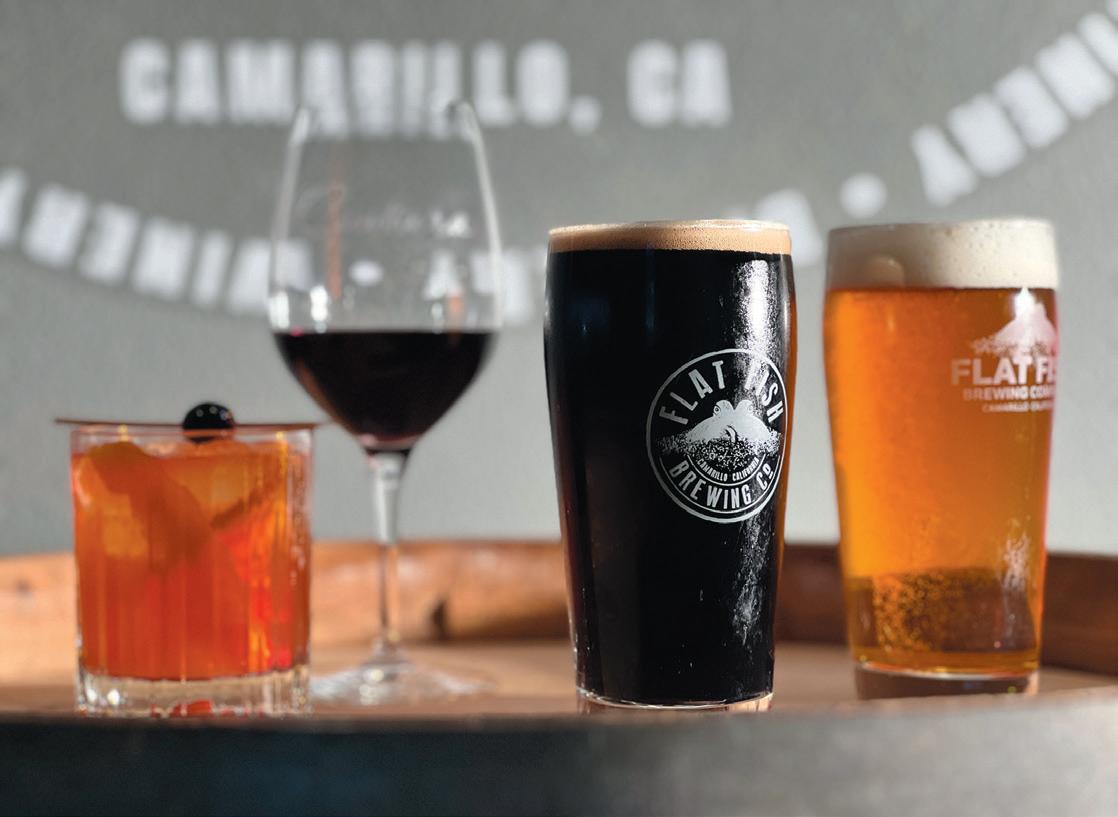
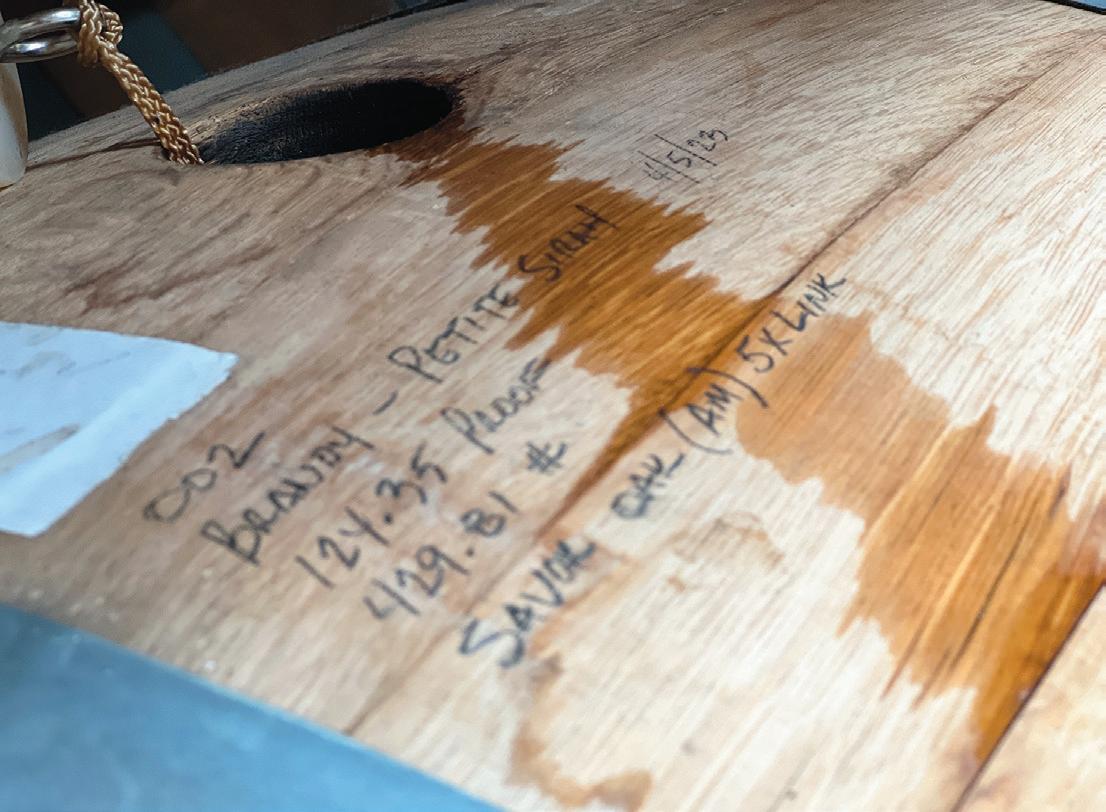
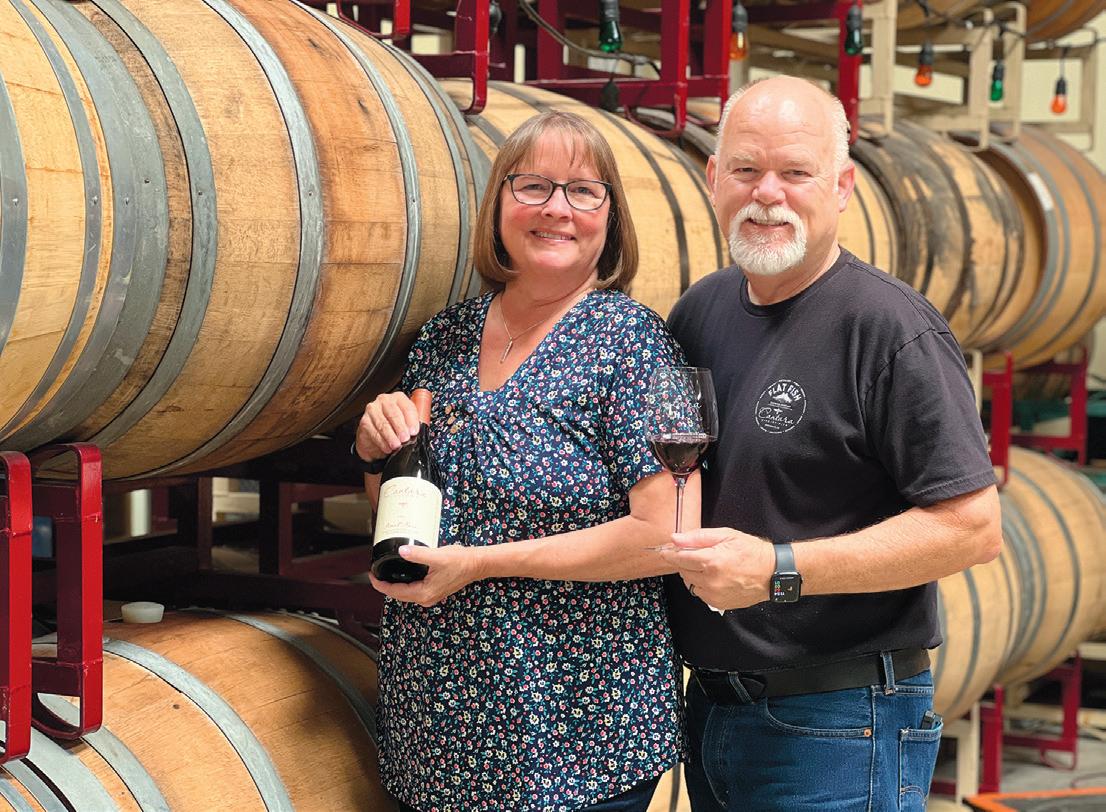
Finding a distributor who would take the time to educate customers and showcase their small brand was out of the question. Brown had no realistic way of taking his product to market.
In 2019, Brown approached California State Assembly Member Jacqui Irwin and started legislative corrective action. According to Brown, the ABC was not fully transparent on the issue, to the legislative analyst, and the session closed without a resolution.
The next year, Brown approached a different legislator but once Covid disruptions emerged all unrelated topics were put aside. By 2022, with the sponsorship of Assembly Member Steve Bennett, AB 1734 successfully passed, allowing wineries and breweries to share retail space. Spirits were left off the bill.
This time, along with the California Distillers Association advocacy, it took another year, another representative, and another legislative session to pass SB 269, which grants craft distillers the ability to share retail space. Finally, the Browns could sell their brandy in the same tasting room where they serve their beer and wine.
“It’s been a brutal process,” says Brown. He has always prioritized his customers throughout the years, inviting them to blending sessions and seeking their feedback.
Ultimately, Mike and Chris Brown didn’t know how people would react to the introduction of a cocktail program and sales of their craft spirits. They’ve been pleasantly surprised, he adds. “Maybe this just happens to have coincided with the evolving desires of the market. I think of it as a win-win.”
Camarillo Barrel Works, Cantara Cellars and Flatfish Brewing 126 N. Wood Rd., Camarillo camarillobarrelworks.com, 805-484-9600
Erika Bolden is a freelance writer based in Southern California. She has written for the Los Angeles Times, L.A. Weekly and All About Beer Magazine. She can be found planting her front yard with California natives or toting a cold one through the backcountry. @erikabolden






•
•
•
•




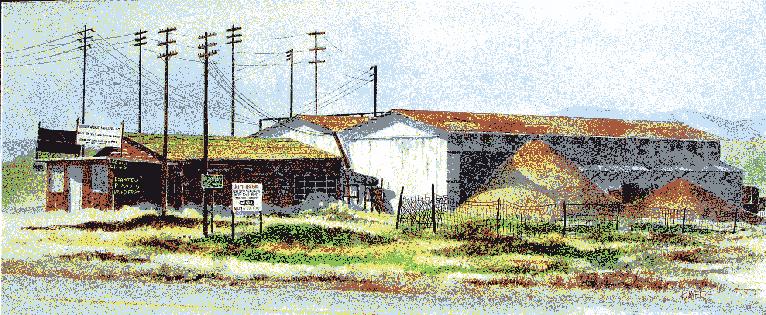


Iam a bona fide wine nerd who enjoys wine in a variety of places—at home, restaurants, wineries—but I also happen to drink a fair amount of wine in hotels. You can learn a great deal about a hotel experience by taking a look at their wine options. Is this going to be a classic hotel experience with lauded wine labels from Napa and Bordeaux? Or is the hotel going for an eclectic vibe with surprising grape varieties from less-explored wine regions?
I recently became curious about who is creating the wine lists at some of our favorite hotels in the area. In addition to their signature restaurants, these individuals are also selecting the wine that is available at the hotel bars and in-room dining. They can really make or break your hotel experience. What are their stories? How did they attain these positions of power dictating what their guests are drinking? What is their approach when selecting their wine lists?
Zachari Dunes is an all-suite oceanfront resort situated on Mandalay Beach in Oxnard. Their all-day restaurant, Ox & Ocean, has outstanding food, beautiful ocean views and a wine list crafted by their director of food and beverage, Ricardo Cubias.

Ricardo holds the Advanced Sommelier Certification from the Court of Master Sommeliers and has 20 years of experience in the wine industry, including opening luxury hotels in Rancho Palos Verdes and Del Mar. He joined Zachari Dunes two years ago and recently started a monthly Sommelier Showcase wine series at Ox & Ocean that takes place on the third Saturday of each month. Ricardo says it is “an immersive journey that empowers guests to delve fully into the intricacies of winemaking.”
Curating their wine list involves selecting wines that offer a range of styles, regions and price points to cater to their customers’ preferences. Ricardo says, “I prioritize wines that showcase quality, uniqueness and value, while also considering current trends and customer feedback.”
He also aims “to offer wines that complement and enhance the flavors of our cuisine, providing guests with memorable dining experiences,” by working closely with Executive Chef Damien Giliberti to create inventive pairings for each dish.
Zachari Dunes offers natural, organic and biodynamic wines to cater to the preferences of environmentally conscious customers. “Customers generally react positively to these bottles, appreciating their sustainable practices and unique flavor profiles,” he says.
Ricardo’s current favorite bottle on the list is the 2022 Gainey Vineyard Sauvignon Blanc from Santa Ynez. He describes the wine as having “tightly wound aromas of green flowers, grass and chilled apple with a sharp citrus core of lime zest.” It is an excellent pairing for either the mussels or seabass on their menu.
Melissa Lamb, director of food and beverage at the Ojai Valley Inn (OVI), oversees all hotel restaurants as well as The Farmhouse, the resort’s culinary events center. Melissa started her career in the wine industry in 2012, planning events for a wine and food nonprofit. She quickly realized she had a passion for wine and made the leap to working in restaurants soon after.
“I’ve worked in independent restaurants, corporate restaurants and now hotels,” she says. Melissa has been at OVI for the last seven years and is a Certified Sommelier through the Court of Master Sommeliers and a Certified Specialist of Wine through the Society of Wine Educators.
As the Inn’s resident expert, Melissa is not only responsible for developing their beverage program, but also putting her personal stamp on engaging wine, beer and spirits tastings at the property. The



ever-evolving beverage landscape of new producers, new products and new trends keeps Melissa inspired and fuels her fervor for the business.
“Our wine list focuses on classic wine regions with a strong focus on Central Coast producers,” she says. She looks for wines that are noteworthy, interesting and food friendly. “Wine and food are so integral to each other, and together, can be a magical experience for the guest.” Melissa’s goal is to introduce Ojai Valley Inn guests not only to celebrated labels from across California, but also, hopefully, to some new and innovative wines that she is especially excited about.
Regarding sustainability, Melissa says, “We have many selections that are following organic and biodynamic practices and a few natural wines.”
As for her favorite bottle on the current list? “I’m really into Niklas Sauvignon Alto Adige 2022,” she says. “I’m loving this lively, bright Sauvignon Blanc from this small family winery in Northern Italy.”
Hotel Californian is a luxury hotel located in Santa Barbara’s vibrant Funk Zone. The hotel is part of Foley Entertainment Group, which allows for collaboration with Foley Family Wines. Hotel Californian offers a strong wine program throughout the property, but is most evident at The Society: State & Mason wine tasting room. The Society features over 70 different wines from the Foley Family Wines portfolio and rotates wines that best represent the spirit and premium quality of their different wineries.
Billie Rolla, a senior trade relations ambassador and wine educator with Foley Family Wines, grew up in the restaurant industry and has long been fascinated with wine. In graduate school, she studied ancient wine through Latin and Greek texts and focused her master’s thesis on a diachronic study of ancient Greek wine. But Billie realized that if she truly wanted to understand wine (ancient or not), she needed to understand how it was made.
“I moved to Santa Barbara in 2017 and worked harvest in 2018—there was no going back.” She began the Wine and Spirit Education Trust (WSET) course of study and is currently working on her WSET diploma.
Billie began working with the Hotel Californian team in 2021 and currently coordinates pairing wine for their monthly Winemaker Dinners and hosts monthly Wine Labs offering “geeky but fun deep dives into different facets of wine.” She also works closely with Hotel Californian’s Executive Chef Travis Watson. “I break down the flavor profile and structural elements of the wine for Chef, who comes up with some exceptionally paired dishes,” she says.
Billie’s current go-to bottle is the Silverado Vineyards GEO Cabernet Sauvignon coming from Napa. “I am a die-hard Cabernet fan, and this cooler region with volcanic soils coming off the slopes of Mt. George brings out all the beautiful complexity, structure and age-ability Cabernet can offer.”
In Westlake Village, The Four Seasons Hotel has a wide variety of wine offerings on property including at their California brasserie, Coin & Candor; their new Cove Pool, Kitchen & Bar; and their weekend late-night speakeasy, Prosperous Penny. Overseeing the wine program is Assistant Director of Food and Beverage Georg Vaessen, who has been with the property since 2016.
Georg has always been fascinated by beverages, especially wine. “I love everything about it,” he says. “The complexity, the art of making it, that it’s slightly mysterious and the fact that you never know everything about it.”
Georg recalls staying at a historic hotel in Switzerland when he was younger. The hotel had a beautiful wine cellar with over 5,000 different wines, he says, and “they took my dad and
me to the cave every day before dinner to select a bottle. I loved the sommelier since he had more time than anyone else on the floor to connect with the guest and make our experience special.”
When curating the wine menu, Georg believes there should be something for everyone. They have a diverse wine list, ranging in price from $60 to $2,400 a bottle and featuring established brands alongside esoteric wines that offer great value.
The hotel’s Executive Chef Jesus Medina works with many local purveyors and farmers to craft their restaurant menus, so it makes sense to have the same approach with their wine list. Georg highlights the best of the best from the nearby Santa Barbara wine region.
Many people now, including Georg, are preferring wines with minimal intervention, so they include sustainable, organic and biodynamic wines on their menu like Scar of the Sea, Elizabeth Spencer, Frog’s Leap and more.
Georg enjoys pairing wine with the mood guests are in. The wine list at the hotel changes frequently, so Georg’s favorite wine is “the wine that surprises a guest and exceeds their expectations for the price they are paying.”
Westlake Village Inn is another wine destination boasting Mediterraneo, their signature restaurant; Bogie’s, a stylish nightclub and happy hour spot; and The Stonehaus, a working European-style vineyard and winery, offering an exciting wine list and in-house wine program.
Westlake Village Inn has two seasoned wine experts at the helm: Jeremy Hamm, the wine director and beverage manager, who recently marked his 10-year anniversary with the inn, and Tim Desmond, the wine manager at The Stonehaus.
Jeremy started his wine journey as a bar manager of a French bistro and later worked at a winery in Santa Ynez, which cultivated his interest in the science of winemaking, wine production and vineyard management.
His eagerness to try new things has made him a perfect fit for the wine industry. “My personality has always naturally helped on the hospitality side of the industry, but the who, what, why is what keeps me learning and growing,” Jeremy says. “As a wine buyer, you must remember wine is subjective, and we buy amazing wines for our guests, not for ourselves.”
His favorite wine? “That’s like choosing your favorite child!” Jeremy laughs. “But two wines I have been loving recently are the Barone di Villagrande, Etna Bianco from Sicily and the Francois Villard Saint-Joseph Poivre et Sol from the northern Rhone Valley of France.”
Tim started as a wine steward at The Stonehaus when it opened nearly 12 years ago. “I have worked in wine my whole life—in all three tiers of the system—producer, wholesaler, retailer.” This experience benefitted him as he worked his way up to wine manager. At The Stonehaus, they have 60 wines by the glass which Tim selects with care. He looks for wines with good varietal character that come from family-owned wineries. Tim has a fondness for good-value wines from Santa Barbara, the Central Coast and Paso Robles. He would say the menu is about 80% California or West Coast. You can order a half glass, whole glass or the bottle at The Stonehaus. Currently, Tim’s favorite bottle on the list is the Melville Estate Pinot Noir from the Sta. Rita Hills.
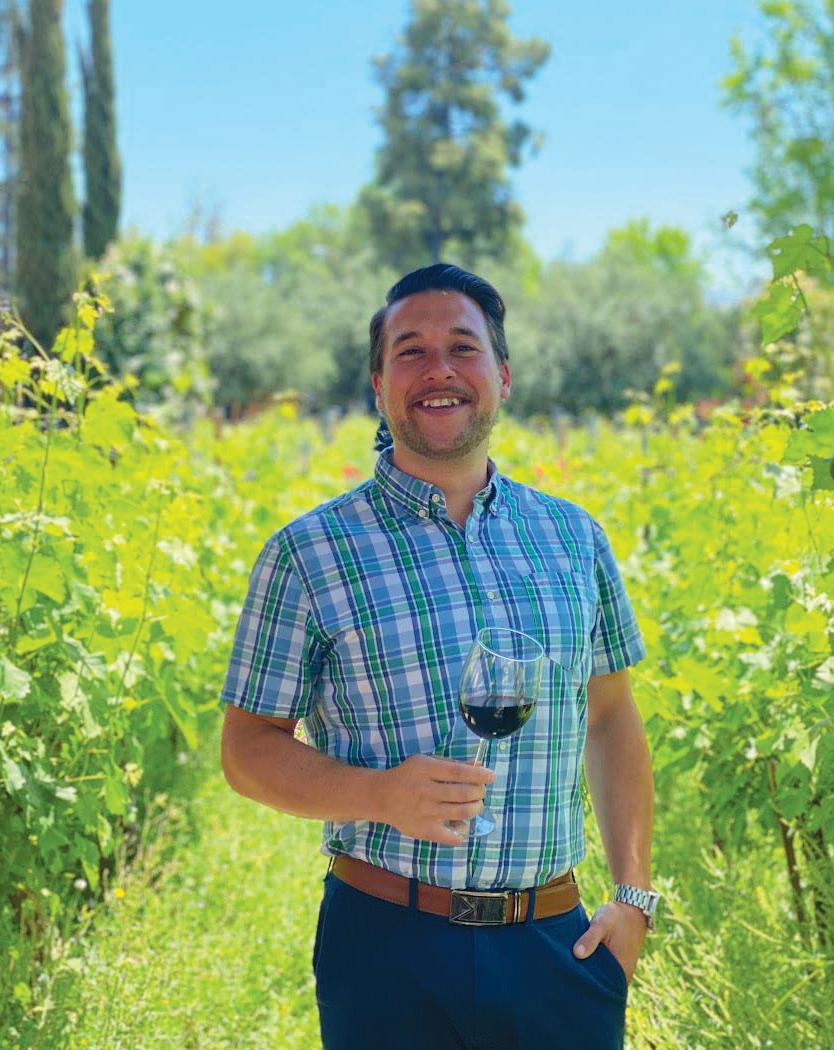

Nicole Leonetti is a freelance writer who has spent her career working in food, wine and hospitality. She received the WSET Level 3 wine certification and is currently studying for her WSET diploma. Nicole writes for local food and travel publications as well as her own blog that focuses on food, wine and travel. LeonettiLiving.com
A sommelier specializes in all aspects of wine knowledge and wine service. Somms gain their designation through a combination of wine study and work experience. Wine certifications can lead to jobs like wine educators, distributors, sellers or producers, or hotel or restaurant wine directors like those in our story. Wine education requires a considerable investment in time and money, so if you are interested in pursuing certifications, you’ll want to pick the program that best fits your goals.
CMS (The Court of Master Sommeliers)—Four levels of sommelier certification: Introductory Sommelier Course, Certified Sommelier, Advanced Sommelier and Master Sommelier. Best for aspiring restaurant sommeliers, as this program has a strong service component. Master Sommelier is considered the highest level that can be obtained in wine knowledge and service—there are currently fewer than 300 Master Sommeliers in the world.
WSET (Wine & Spirit Education Trust)—Four qualification levels in wine, ranging from Introductory level 1 to level 4, which is an intense diploma certification. Focuses on wine knowledge and is perfect for those who work in the wine trade as well as wine enthusiasts. This can serve as a stepping-stone to Master of Wine.
IMW (Institute of Masters of Wine)—More academic and theoretical in approach than CMS. Focuses on winemaking philosophies, wine analysis and the business of wine. The Master of Wine designation is considered the highest standard of professional wine knowledge—there are currently fewer than 500 Masters of Wine in the world.
SWE (Society of Wine Educators)—The Certified Specialist of Wine (CSW) credential focuses on wine knowledge and mastery of viticulture and winemaking. The Certified Wine Educator (CWE) credential combines wine knowledge with a focus on tasting acumen and teaching ability. Perfect for those interested in the wine education field.




 Photo by Stephanie Helguera
Photo by Stephanie Helguera
Paradise Pantry, nestled in its cozy space on historic Main Street in Downtown Ventura, is a culinary haven, housing a symphony of flavors. With its multifaceted offerings—restaurant, cheese counter, wine shop and artisan market—it is indeed a gastronomic paradise.
Under the guidance of award-winning Chef Kelly Briglio (pictured left), the restaurant celebrates the bounty of the Central Coast, sourcing ingredients from local farmers and artisans. Wine Consultant Tina Thayer (pictured right) curates weekly wine flights, the wine shop and their exceptional wine and cheese club with a lovely selection of hard-to-find and easy-to-drink wines. Together, their passion and creativity shine, making Paradise Pantry a sanctuary for food lovers to savor life’s finest pleasures, in an ambiance of warmth and hospitality.
Paradise Pantry
222 E. Main St., Ventura ParadisePantry.com; @paradisepantrymarket

7. “Seaside Pathways,” photograph on canvas by Stephanie Hogue available in multiple sizes at Latitudes Art Gallery | 401 E. Main St., Ventura | LatitudesGallery.com
8. Monterey County 2021 Kristy Vineyard Pinot Noir by Certified California Sustainable Winegrower Flying H Wines. Available for purchase online. | HobsonFamilyFarms.com/flying-h-wines
9. Hand Crafted Baked Strawberry Cinnamon Donuts and Whoopie Pies made with Chocolate Brownie Olive oil cookies and filled with organic strawberry, horchata or chocolate gelato all made in-house at CRAVE Gelato Kofi Bar | 947 Schooner Dr., Suite 105, Ventura | GelatoKofiBar.com
10. Single Origin Locally Roasted Whole Bean Coffee; Blends shown are Dawn Patrol medium roast with notes of fig, raw hazelnut and orange; Night Hike dark roast with notes of dark chocolate, nutty and smoky; and Velvet Sunshine espresso roast with notes of dark cherry, fudge and caramel. Available at Ragamuffin Coffee Roasters and online. | 111 N. Reino Rd., Newbury Park | RagmuffinRoasters.com
11. Handcrafted, small batched Honey & Bamboo Facial Scrub made with biodegradable bamboo microbeads, raw honey, organic oils and wild-harvested herbal extracts by Earth Tonics Botanical Skincare | Available online or in the store | 416 Bryant Circle, Suite O, Ojai | EarthTonicsSkincare.com | Use code EDIBLE15 for 15% off first order online.
 BY STEVE SPRINKEL, ILLUSTRATIONS BY RAMIAH CHU
BY STEVE SPRINKEL, ILLUSTRATIONS BY RAMIAH CHU
Gardening nomenclature can be so unnecessarily obscure. For example, what’s the enigmatic meaning of an indeterminate tomato? And who would want one if the tomato seemed so undecided? Does the tomato really know what it is, or is its nature still to be determined? Confronting a nursery product that identifies as a mystery does not bode well at the cash register.
To summarize: A determinate tomato sets fruit quickly at a height of three feet. An indeterminate tomato takes longer to bear, like the famous heirloom tomatoes Brandywine and Cherokee Purple, which sprawl indeterminately; some say indifferently. Rules are for other tomatoes, like Celebrity, a tasty semi-determinate with plenty of give.
Determinate tomatoes offer a ripe shortcut to tasty gratification. They sound like a tomato you can trust. And the beauty of it is you need not truss determinates as one needs to bind up the inde terminate tomato. Merely hammer three mod est 1- by 2-inch sticks in the ground and begin to wrap the tomatoes upright. The three make a triangle, you see. Those galvanized tomato cages are better meant for determinates; such are reusable for years. (Anything per manent is good for soul and planet.) The cages will need at least one vertical mate pounded into the ground to support the weight that will arrive in July.
Plant plenty of them and your marinara fame will tsunami the neighborhood.
The basic nature of the indeterminate tomato is that the tomato vine will keep growing for an indeterminate amount of time. One needs to build a vast armature of posts and twine and buttresses to keep your wandering indeterminate tomato from collapsing onto the soil where night-venturing critters will gnaw on them while you sleep. You obtain big flavor for big effort. This is a garden fact, but underscored for tomatoes because they gather so much admiration. By contrast, few people brag about or are impressed by zucchini unless they are unbelievably large.

A determinate tomato plant
The vast buttressing for tomato safety is, of course, a defense against such mischievous swine as the sow bug, earwig and weevil. If you experience sudden overnight chew-marks on your garden foliage look not to the sky for an innocent bird, but come long after dusk with a glowing flashlight loaded with fresh double Ds and you will encounter the horror.
Where did all the snails and slugs come from? They dwell by day in that tangle of ivy between you and the Rasmussen family, where a friendly green border allegedly meant to provide security instead provides no safety from what lurks within such dank, leafy confines. Competent garden detectives observe if there be a crevasse in the garden stonework, trouble waits there for sundown.
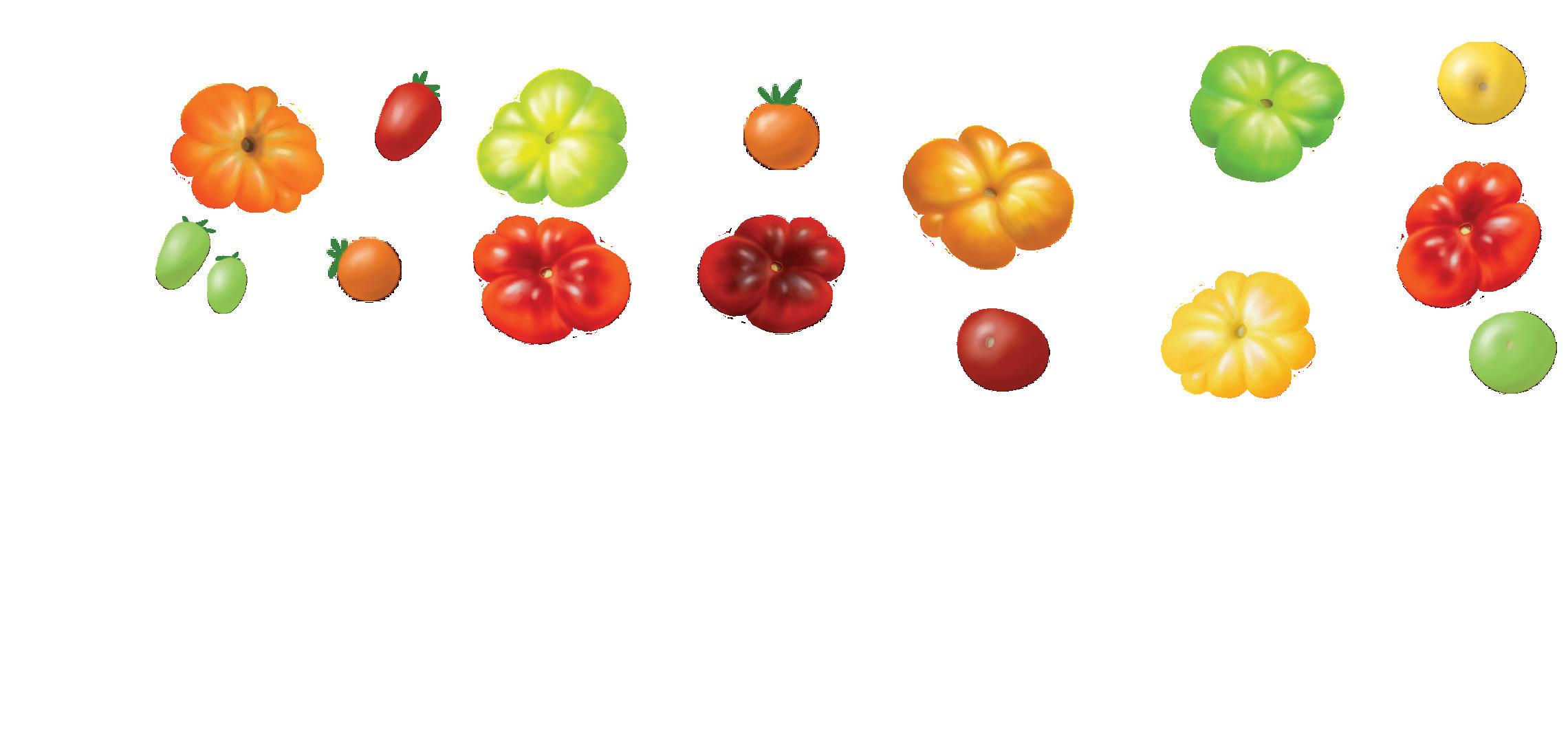
that, by their nature, gardeners might be more compassionate than someone who spends their weekends hunting down their friends in a paintball circus. Gardeners can trap their simple adversaries, laying out cardboard or wooden carpentry cast-offs to gather hidden vermin by day, but what then? Why the vegan claim if we select exemptions? I scoop the insects and gastropods into a bucket of soapy water to be rid of them. This callous depravity is easy for me to perform because I have done it for decades. I can promise you, earwigs will not be on the endangered list soon.
You do have an alternative to murder. Just repatriate whatever is bugging your garden to a wild place by the side of the road—like on Olivas Park Drive, or out on Highway 150 west of Ojai. There are laws prohibiting the release of trapped vertebrates, meaning squirrels or rabbits, into the wild because you donate a voracious nuisance to a stranger. There even may be a law against catching and releasing earwigs. No one would want strangers repatriating earwigs and tomato hornworm caterpillars in front of their home, so find a wild place for the wildlife and you will return with a nifty anecdote to share with squeamish friends who have PETA stickers on their refrigerators.
By committing the act of gardening you are disturbing an accidental nature. The nature is there by accident rather than by design, unless you subscribe
to the Great Diviner. Gardeners dig up soil and expose a billion microbiota to the harsh glare of the sun. Potato bugs waddle off muttering about our insincerity. Earthworms are appalled by our
Edible Ojai & Ventura County since the early days. A longtime commercial organic farmer, he co-owns Farmer and the Cook with his wife,
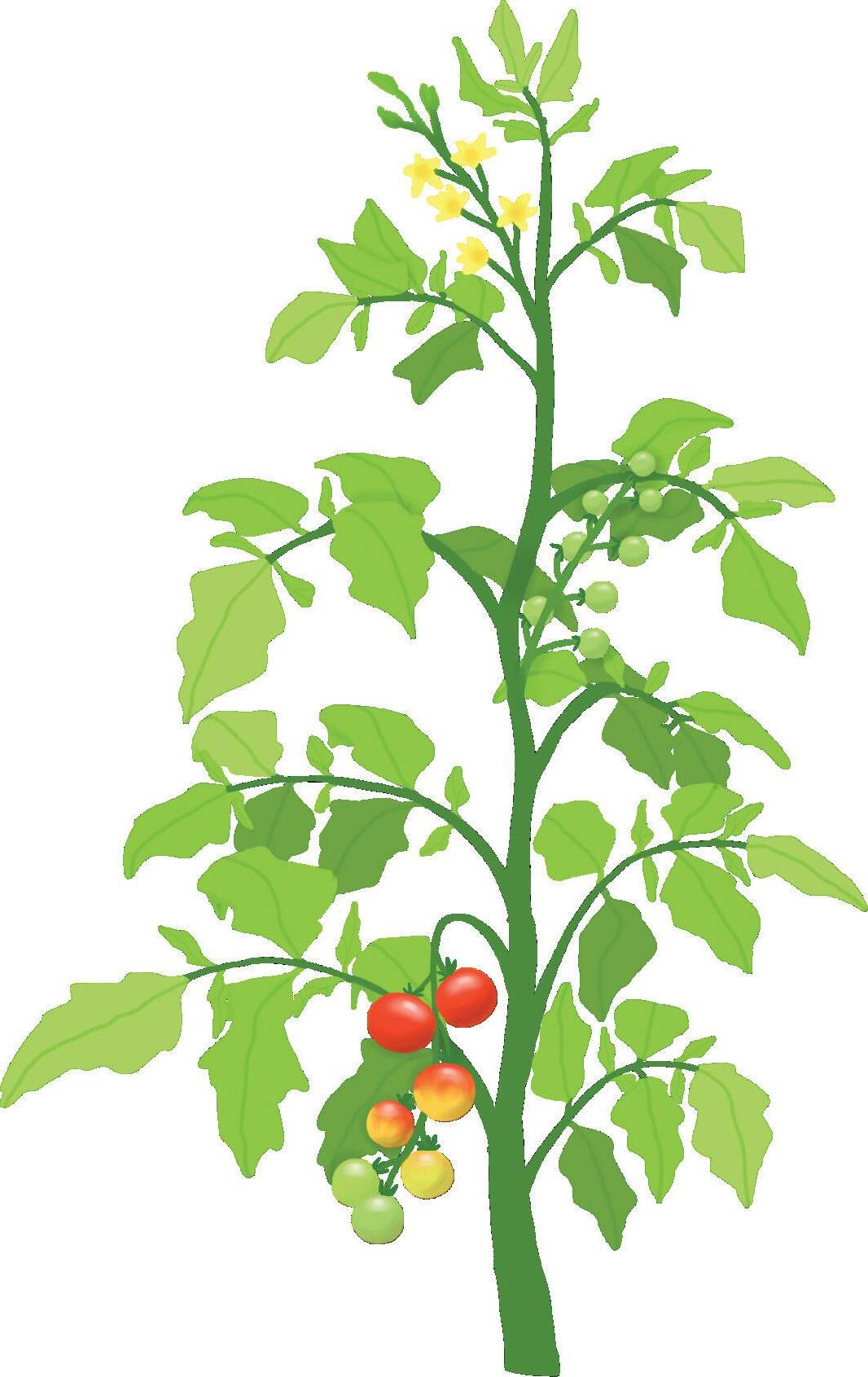
By committing the act of gardening you are disturbing an accidental nature. The nature is there by accident rather than by design, unless you subscribe to the Great Diviner.
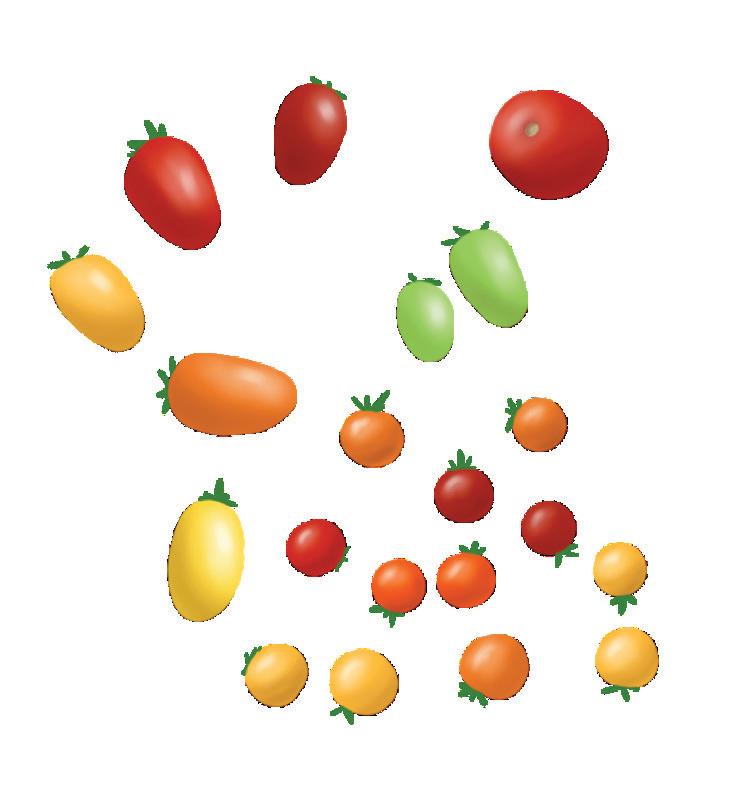
TUESDAYS
Simi Valley
Adventist Health Farmers Market NEW! 3000 Sycamore Dr. Tuesdays, 10am–3pm @svfarmersmarket
WEDNESDAYS
Midtown Ventura
Certified Farmers’ Market
Pacific View Mall (West End Parking Lot) 3301 N. Main St.
Wednesdays, 9am–1pm (rain or shine)
VCCFM.org
805-529-6266
THURSDAYS
Downtown Oxnard
Certified Farmers’ Market
Plaza Park, 5th St. & B St.
Thursdays, 9am–1:30pm (rain or shine)
OxnardFarmersMarket.com
805-247-0197
Ojai Community Farmers’ Market
Chaparral Courtyard 414 E. Ojai Ave.
Thursdays, 3–7pm
OjaiCommunityFarmersMarket.com 661-491-0257
Thousand Oaks
Certified Farmers’ Market
The Oaks Shopping Center (East End Parking Lot) Wilbur Rd. & Oaks Mall Dr.
Thursdays, noon–5pm (rain or shine)
VCCFM.org
805-529-6266

FRIDAYS
Simi Valley
Certified Farmers’ Market Civic Center Plaza 2757 Tapo Canyon Rd. Fridays, 11am–3:30pm (rain or shine)
Facebook.com/SimiValleyMarket
805-643-6458
SATURDAYS
Agoura Hills At Whizen Market Square 28914 Roadside Dr. Saturdays, 10am–3pm @ccfminc
Camarillo Hospice
Certified Farmers’ Market
2220 Ventura Blvd., Old Town Saturdays, 8am–noon (rain or shine)
CamarilloFarmersMarket.com
805-987-3347
Downtown Ventura
Certified Farmers’ Market
200 Block of Main St. From Palm to Mission Park Saturdays, 8:30am–noon (rain or shine) VCCFM.org
805-529-6266
Santa Paula Certified Farmers Market
At Anna’s Cider 801 E. Main St. Saturdays 10am–2pm anadaluyt@gmail.com
Ojai
Certified Farmers’ Market
Behind the Arcade
300 E. Matilija St. Sundays, 9am–1pm (rain or shine)
OjaiCertifiedFarmersMarket.com 805-698-5555
Moorpark
Certified Farmers’ Market 450 High St. Sundays, 9am–2pm EnrichedFarms.com 818-699-6204
Community Market At Oxnard College Campus Parking Lot Sundays 8am–3pm Maria_olivares2@my.vcccd.edu
Channel Islands Harbor Farmers’ Market
Marine Emporium Landing 3350 S. Harbor Blvd., Oxnard Sundays, 10am–2pm (rain or shine)
RawInspiration.org 818-591-8161
Westlake Village Farmers’ Market
2797 Agoura Rd. Sundays, 10am–2pm (rain or shine)
RawInspiration.org 818-591-8161
Ventura College Foundation
Weekend Marketplace
Ventura College East Parking Lot Corner of Telegraph Rd. & Day Rd. Saturdays & Sundays, 8am–2pm VenturaCollegeFoundation.org
Note: All info was updated in May 2024. As details do change, please contact the markets for the latest info.
See EdibleVenturaCounty.com for CSA information.




Visit Roan Mills for fresh pastries and housemade sandwiches
NEWBURY PARK/OXNARD
Ragamuffin Coffee Roasters
Family-owned and -operated coffee shop and bakery with ethically sourced coffee, gluten-free pastries and excellent service.

111 N. Reino Rd. | Newbury Park | 805-375-9000 and 550 Collection Blvd., Ste. 130 | Oxnard | 805-278-5837 | RagamuffinRoasters.com
Ox and Ocean
Tying into the unique makeup of California, Ox & Ocean serves locally sourced produce and seafood fresh from Oxnard’s plains and sea, celebrating a diverse influence and distinct flavors in an elegant, yet approachable fashion. 2101 Mandalay Beach Rd. | Oxnard | 805-984-2500 | OxandOcean.com
Butter and Fold
Coffee and pastry bar with a focus on local farmers’ market fruit and veggies, locally roasted coffee and pastries made with the finest organic and grass-fed ingredients.

2126 E. Thompson Blvd., Ventura | @butterandfold
Crave Gelato Kofi Bar

Ventura Harbor’s coffee and dessert bar with premium organic coffee, lattes and curated cold-brews, handcrafted plant-based gelato and even pup-cups.
947 Schooler Dr., Ste. 105 | Ventura | 805-918-0553 | GelatoKofiBar.com
Limón Y Sal

Authentic
Mexican dishes made from scratch with fresh local Ingredients. A Downtown Ventura favorite for over 20 years, serving breakfast, lunch and dinner, including vegan options and award-winning margaritas.
598 E. Main St., Ventura | 805-628-3868 | LimonySalVentura.com
Paradise Pantry
Food with a local emphasis, including great sandwiches, salads, mac ‘n’ cheese, gourmet goodies, a cheese counter and an extensive wine shop. Diners can also enjoy craft beers, wines by the glass or wine flights.

222 E. Main St. | Ventura | 805-641-9440 | ParadisePantry.com
Poseidon Brewing Company
A small, local, veteran-owned craft brewery making a variety of beer styles. Visit the tasting room or take a growler to go.

5777 Olivas Park Dr., Ste. Q | Ventura | 805-477-0239 | PoseidonBrewingCo.com
Ventura Spirits
Since 2011, using the natural and agricultural bounty of California’s Central Coast to hand craft novel and delicious spirits.

3891 N. Ventura Ave. | Ventura | 805-232-4313 | Order online at VenturaSpirits.com

Please visit our advertisers and let them know you appreciate their support of Edible Ojai & Ventura County. They enable us to offer this magazine free of charge to readers throughout Ventura County.
The Cove Pool, Kitchen & Bar at Four Seasons Westlake Village
Situated on 2 acres, this luxury pool concept offers an outdoor restaurant and bar celebrating seasonal and locally sourced ingredients with a Baja Med menu created by Chef Jesus Medina.

2 Dole Dr., Westlake Village, 818-575-3000, Fourseasons.com/westlakevillage/dining/restaurants
Roan Mills Bakery
California’s first land-to-loaf bakery, Roan Mills grows the wheat, mills the flour, bakes the bread and makes the pasta. Stop in at their bakery in historic downtown Fillmore and taste the difference.
411 Central Ave. | Fillmore | RoanMills.com
Private ChefCatering


Robin Goldstein is a California chef who works her culinary magic combining unique flavors and seasonal ingredients with classic techniques inspired by her extensive travel around the Mediterranean. PrivateChefRobin.com

All Things Tea European teahouse with certified Tea Specialist. Specialty loose leaf teas from the finest plantations and gardens around the world. Cream Tea, Afternoon Tea and High Tea.

In Paseo Camarillo Center | 300 N. Lantana St., #37 | Camarillo | 805-445-8327 | Tea-Liteful.com
Onyx Bistro Woman-owned and -operated, serving a casual but refined seasonal menu made with locally sourced ingredients and paired with local craft beers and wine. Indoor and outdoor seating and live music on weekends.

2390 Las Posas Rd. Ste. H | Camarillo | 805-991-7356 | OnyxBistroCamarillo.com

The Wine Closet Wine lounge in Old Town Camarillo, featuring unique wines, craft beers, small plates, lunch and dinner. Weekly happy hours and featured wine tastings. Indoor and outdoor seating. The specialty market offers retail sales of fine wines, craft brews, artisan cheeses and charcuterie.
2423 Ventura Blvd. | Camarillo | 805-746-5708 | WineClosetInc.com

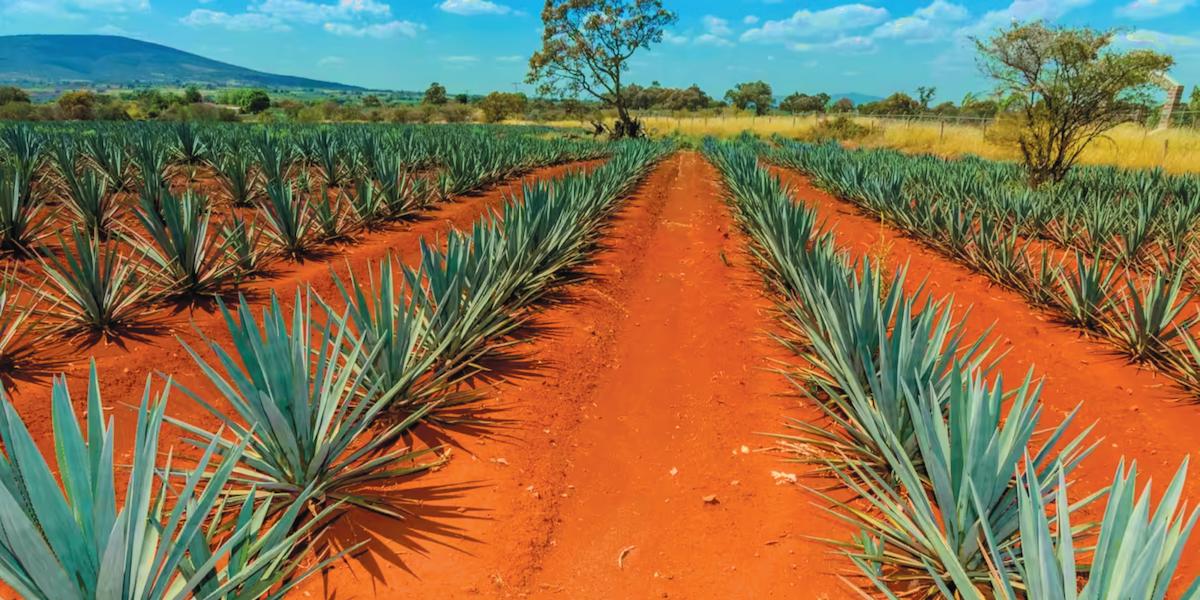



Recipe and photo courtesy of Limón y Sal
Use any firm, non-oily, white-fleshed fish (snapper, grouper, flounder, sea bass) and for best results, use fish the day it is purchased.
Serves 6–8
4 fish fillets
1½ cup fresh lemon/lime juice (best to use a combination of lemon and lime)
1 large red or purple onion, diced small
2 medium-size fresh jalapeños, seeded and deveined, diced fine
2 large ripe but firm tomatoes, diced small
½ cup fresh cilantro, finely chopped
½ teaspoon salt

Cut fish into small bite-sized pieces. In a bowl, combine fish and lemon/lime juice and stir until fish is fully covered. Cover and allow to marinate in the refrigerator for at least 2 hours.
Add rest of ingredients to the bowl and stir. Serve immediately in a serving bowl placed over ice, with tortillas or chips. If you want to get fancy, scoop the ceviche onto individual plates, top with sliced avocado and cilantro and serve with crisp corn tortillas.
Note: This is a partysized recipe. For a smaller portion, cut the recipe in half but make sure the fish is completely covered in the lemon/lime juice for the marinade.


$32,500

TOTAL IN CASH PRIZES AWARDED TO MARKETS
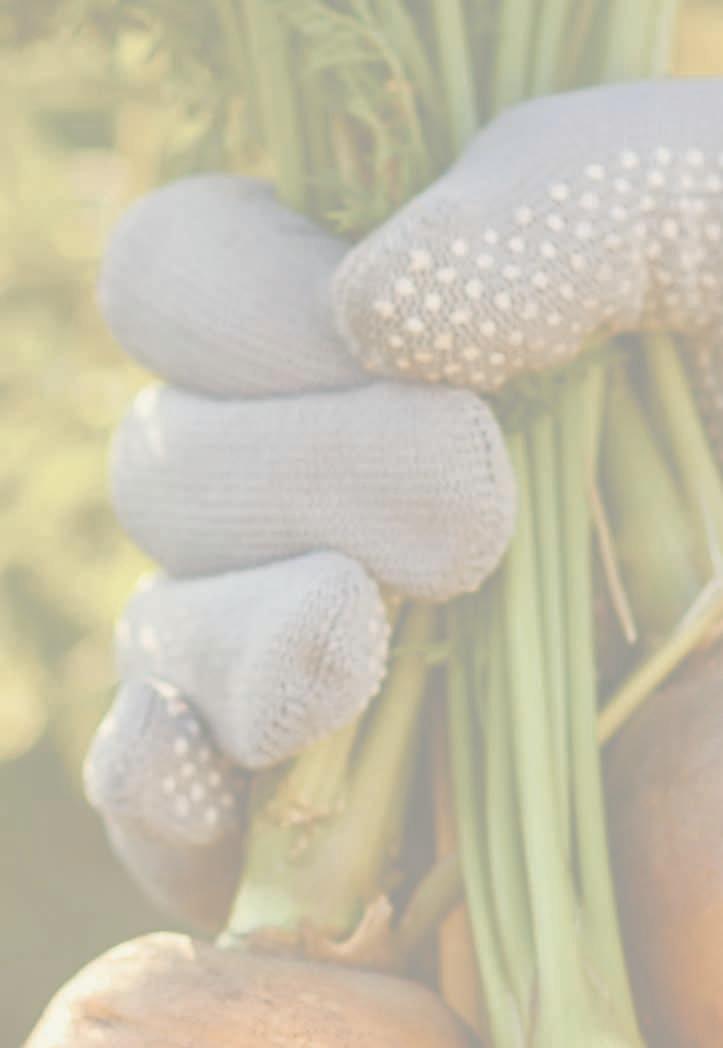

2,435
MARKETS PARTICIPATED IN 2023

VOTE FOR YOUR FAVORITE MARKET
